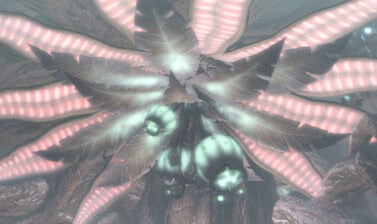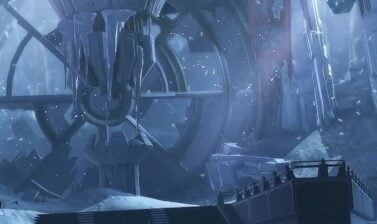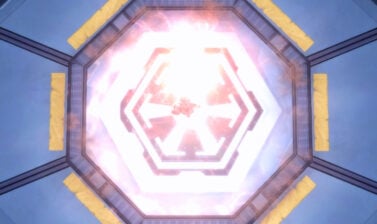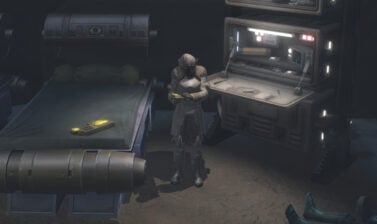Beginner-friendly guide to the PvP Ancient Hypergate Map in SWTOR. Details the rules of the game mode, the Map layout and its secrets, class-specific and general recommendations, tips and strategies!
The guide is up-to-date for Patch 7.8
Table of contents
Introduction
Even with the use of hyperdrives to enter the alternate dimension known as hyperspace to drastically cut galactic travel time, many still seek to gain a faster means of travel. Such beings include those who are part of the Republic and the Sith Empire.
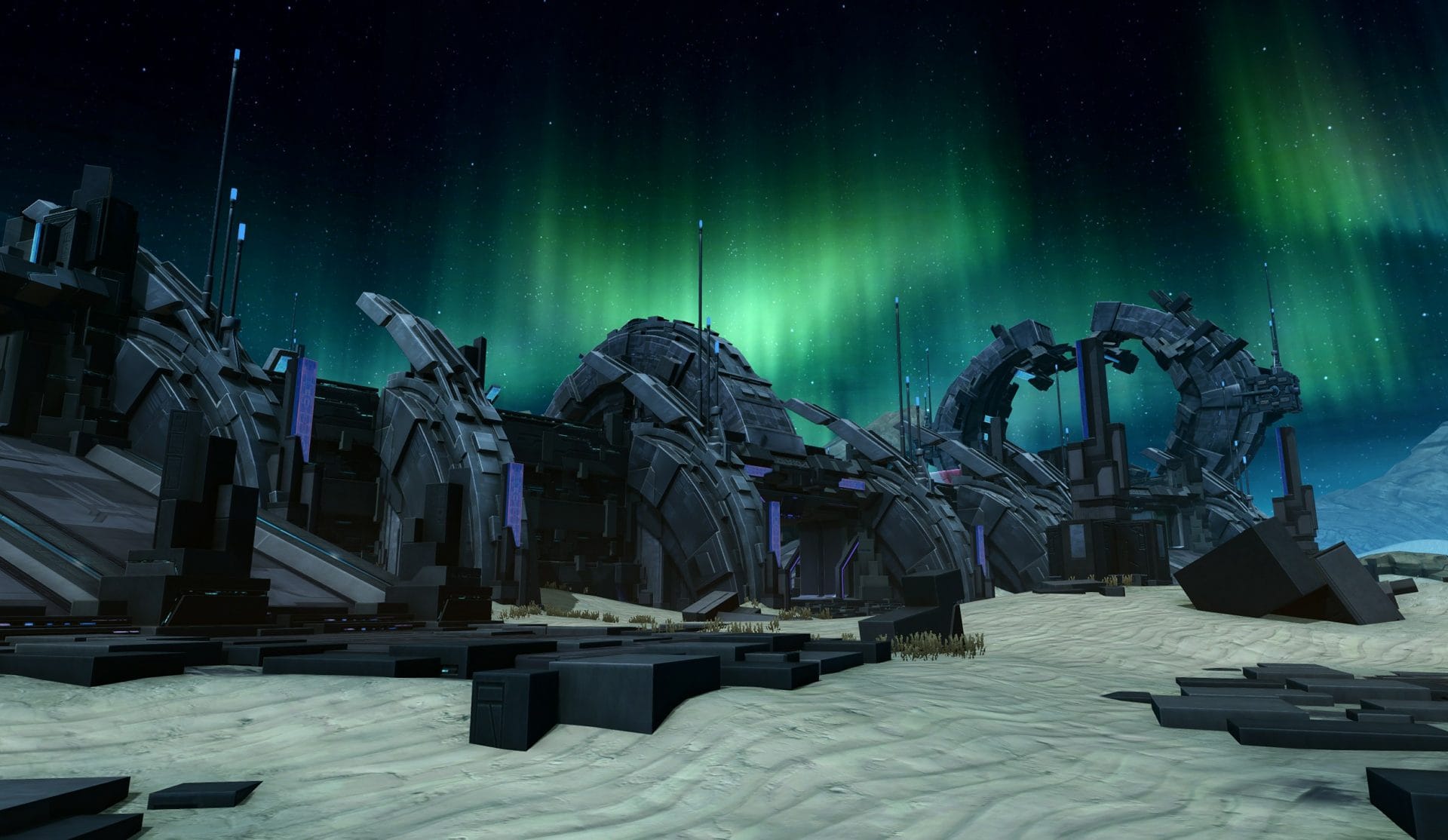
In the Ancient Hypergate warzone, you’ll be emulating a conflict between two teams who seek to gain control of one of these ancient hypergates built by the Gree a long, long time ago in a galaxy far away. With it under a faction’s control, perhaps they can unlock the secrets to hypergate travel.
Like many of the other 8v8 maps in Star Wars: The Old Republic, the Ancient Hypergate Warzone has two teams seeking to gain control of an objective and to gain points while maintaining said objective.
In this case, the two teams will seek to control and fuel the energy pylons found on this map before they detonate and kill anything not in a sheltered area. In this guide we’ll be going over the various aspects on the map and get into how you can best help your team win this map.
Rules of Ancient Hypergate PvP Match
The Ancient Hypergate warzone features two energy pylons that opposing teams will attempt to take control of. From there, they seek to either defeat enemy opponents or grab energy orbs from Gree cubes to bring back to their pylon.
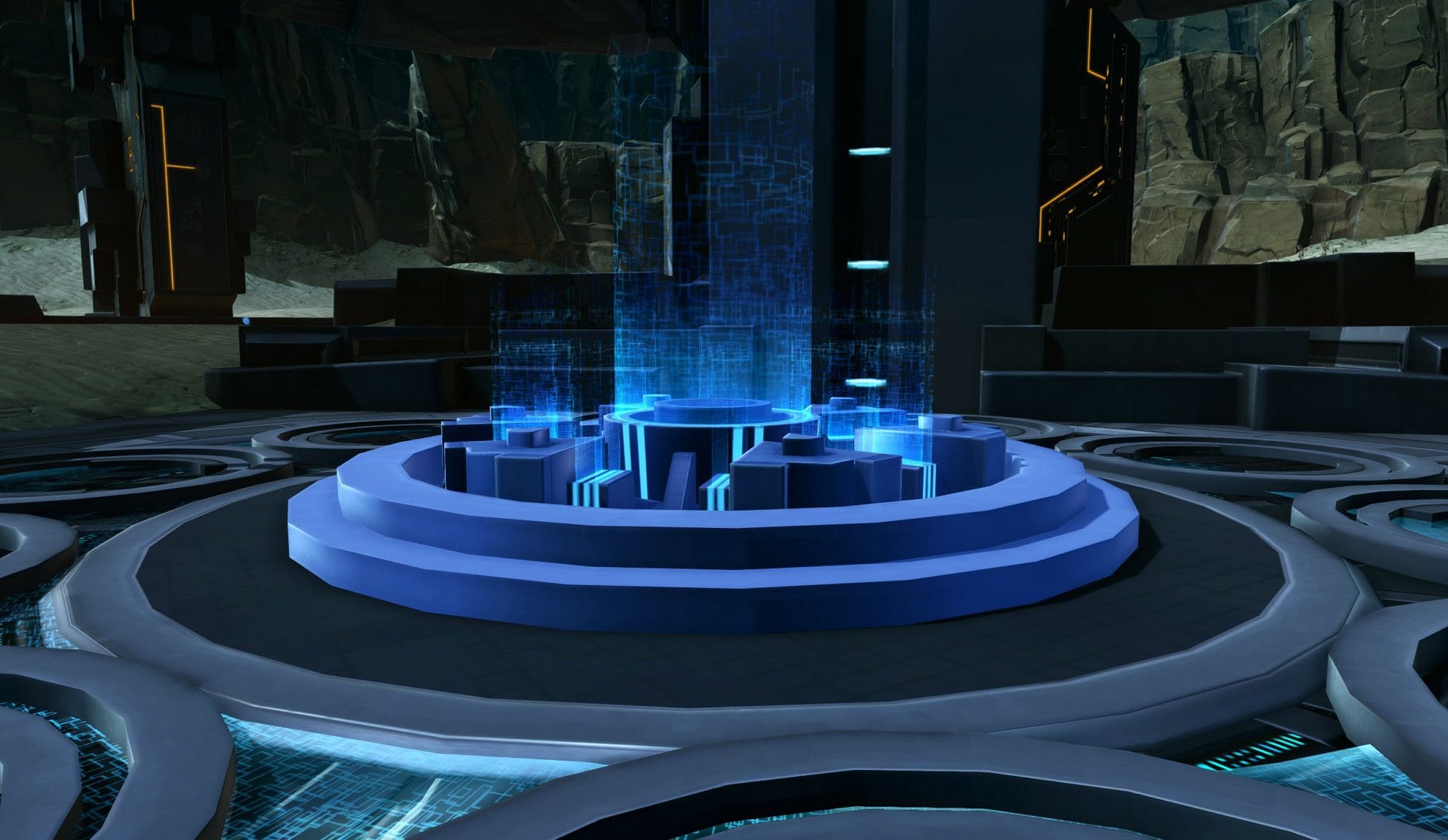
Both kills and feeding energy orbs to allied pylons will increase their team’s points per round. The warzone is completed once a team has gained at least 600 points at the end of a round. Each round of this warzone will last 2 minutes and 30 seconds.
To the East and West of the map, you’ll find a single energy pylon. The two teams will attempt to gain control for at least one of these or both if they’re confident or cocky. Once the teams are permitted to leave the spawn zone, it becomes a race to secure at least one pylon.
It will take 8 seconds to capture a pylon for the team and as with any channeled ability, direct damage will stop this. Capturing a pylon earns a team points with the amount increasing slightly after each successive round. Allied pylons will appear green while enemy pylons will appear red.
At the center of the map in the shelter zone are four Gree cubes that can be interacted with. It takes 5 seconds to do so but when done, the player will be carrying energy as shown by the small orbs now hovering above them.
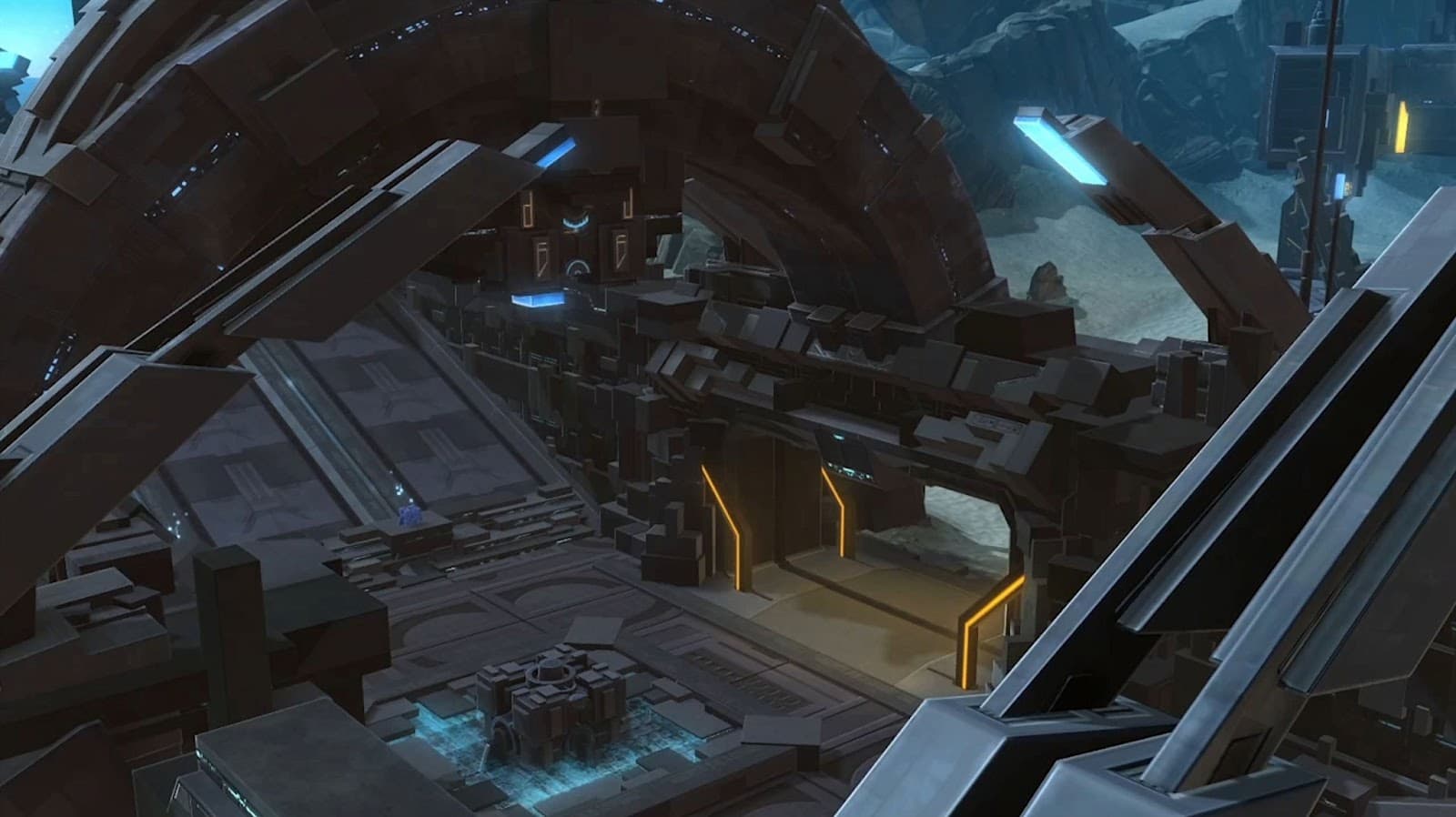
They must bring these orbs back to an allied pylon before the round ends or before getting killed by opposing team members. An orb will grant 18 points in the first round with the number of points increasing slightly with each successive round.
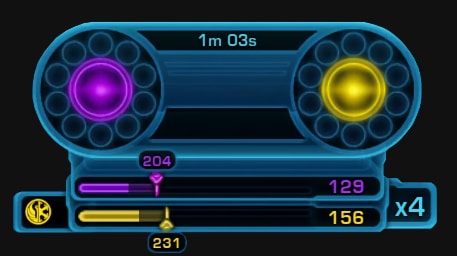
You’ll see this UI in your HUD when you enter the Ancient Hypergate warzone. You’ll have an indicator on the lower left to show which team you’re on, gold or purple.
The score bar will have solid and transparent portions filled out. Solid parts of the bar are points the team has already earned while the transparent portions are the potential points earned during the round.
If a team loses control of a pylon, they’ll lose potential points while the other team gains potential points. This means they can steal any potential points an enemy team built up by stealing their pylon. At the start of the next round, any potential points are converted into confirmed points.
On the right of the score bars is the round’s kill score multiplier. It will start out as “x3” meaning kills grant 3 points. Each successive round will have the multiplier increased by 1 so it will go from x3 to x4 to x5 and so on.
At the very top of the UI is a timer with the status of the two pylons under it. In the image above, the East pylon is under control of the purple team while the west pylon is under control of the gold team. When the pylons are not under control, they will appear blue.
After a round ends, the pylons will begin to charge up. You can see this time as shown by the smaller circles circling the pylon markers in the UI.
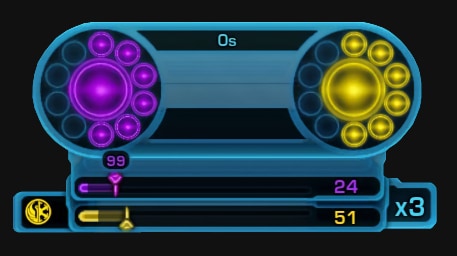
Once all of these are filled, they’ll convert into the image below. This indicates actively detonating pylons so anyone not in the center or side shelter zones will be killed if the explosion touches them.

After detonation, the new round will begin where each time will need to recapture pylons and either gain kills or take energy orbs back to their pylons.
Ancient Hypergate Map Layout Overview
This is a fairly simple map as the two pylons are either referred to as the “East Pylon” and the “West Pylon”, or just East and West respectively.
In the center of the map and below the spawn points are shelter zones where one can be protected from energy discharges coming from the pylons at the end of the round.
Though in order to take advantage of the side shelter zones beneath spawns, one will need to reach them before the countdown at the end of a round is up otherwise they’ll be locked out. The middle shelter zone will always allow passage but will often see the most conflict during the warzone.
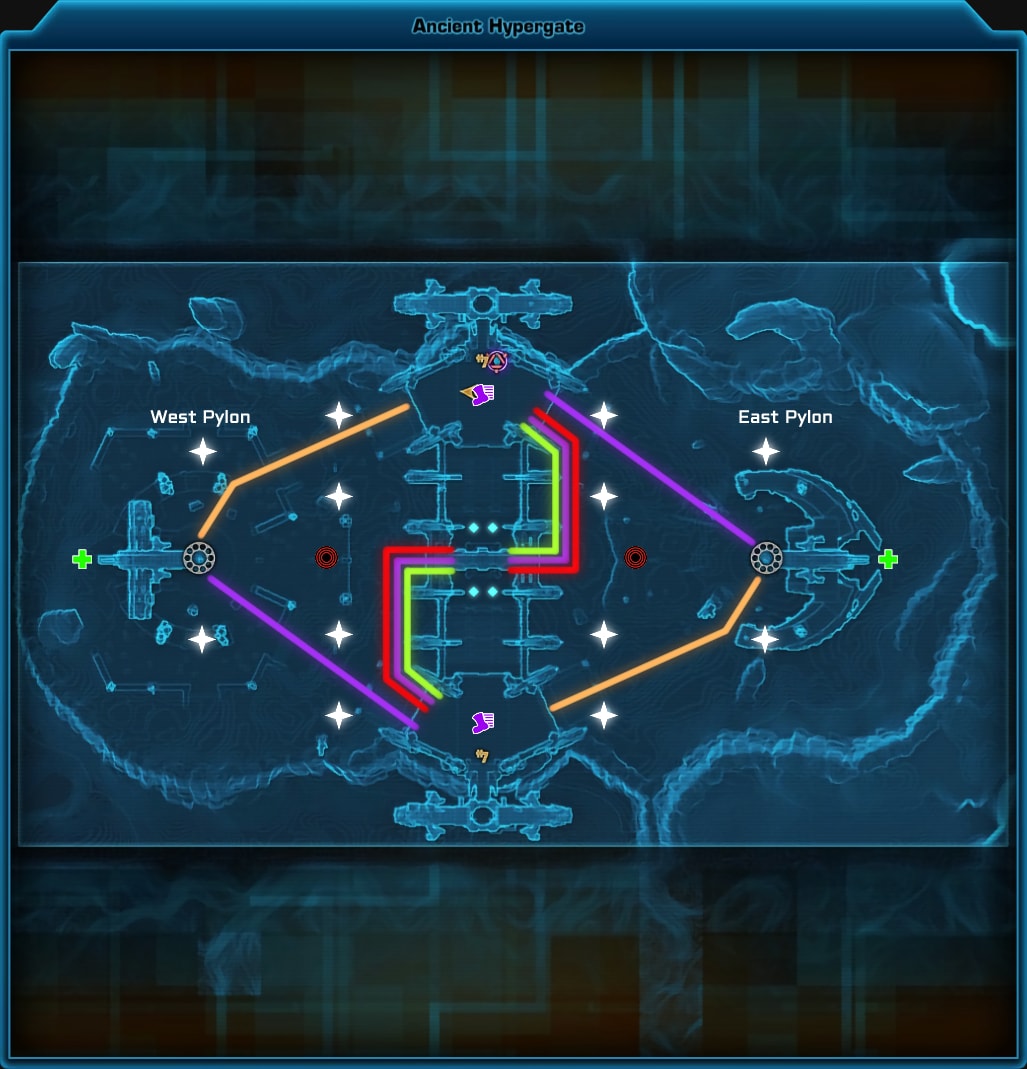
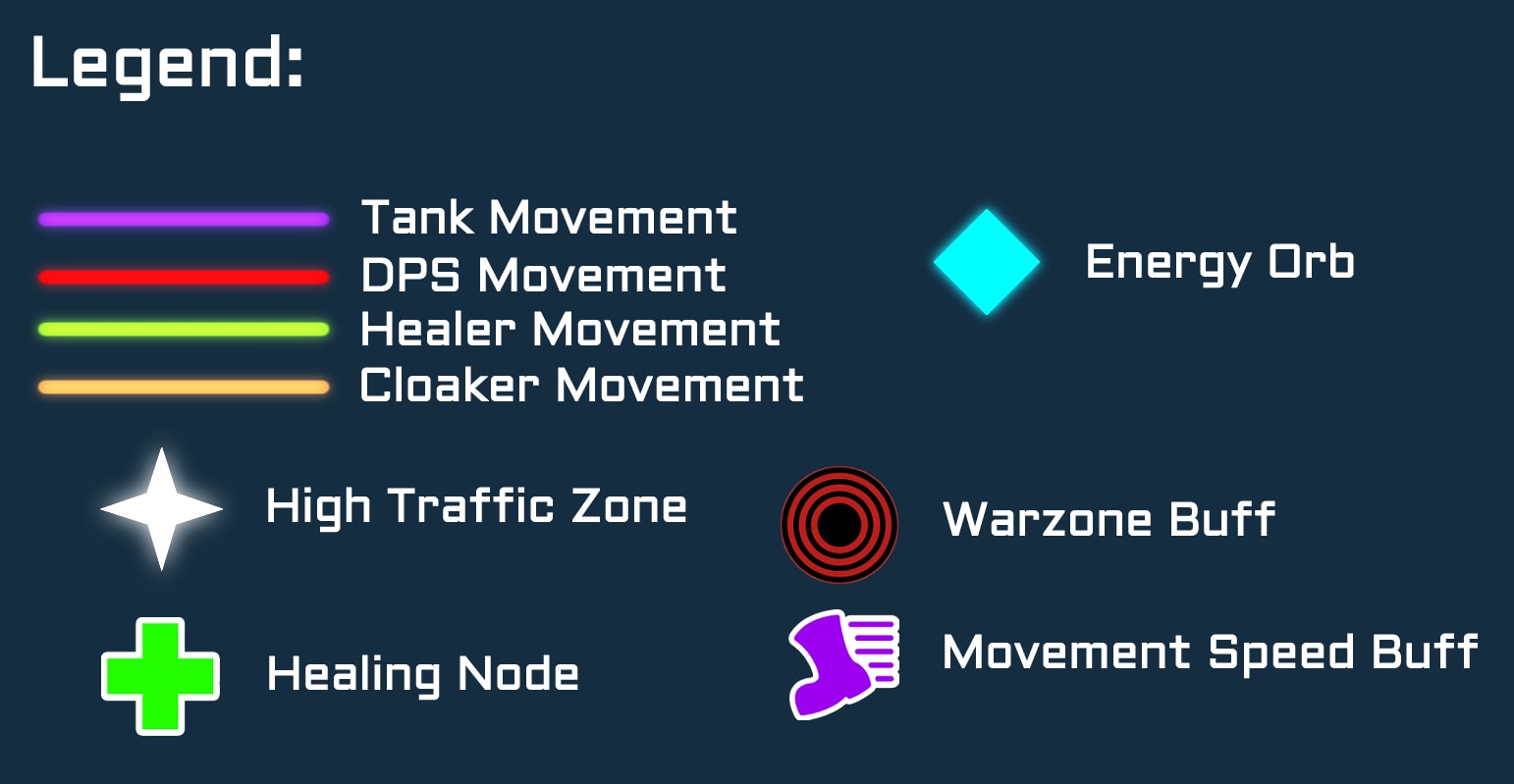
- Tank Movement: These lines indicate the typical paths tanks will take, usually one to guard an objective and another to fight on the front lines.
- DPS Movement: These lines indicate the typical paths DPS units will take, usually straight to the heat of the battle.
- Healer Movement: These lines indicate the typical paths healers will take.
- Cloaker Movement: This indicates where stealth units such as Shadows/Assassins and Scoundrels/Operatives move, typically at the start of the battle.
Healing Node
Touching this instantly restores a large chunk of your health. These appear behind pylons.
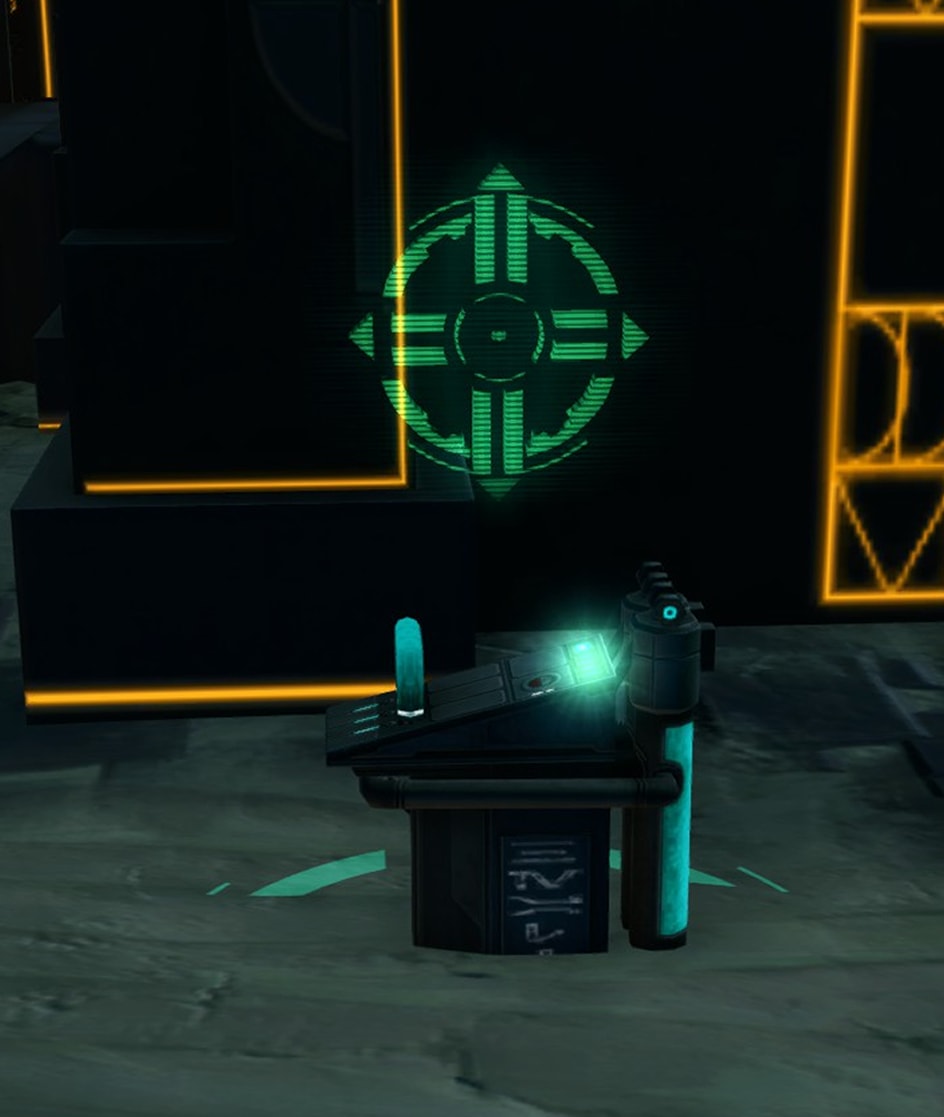
PvP Warzone Buff
This is a buff that increases damage done, healing done and reduces damage taken vs players by 15% for a short time. These appear on the paths towards pylons.
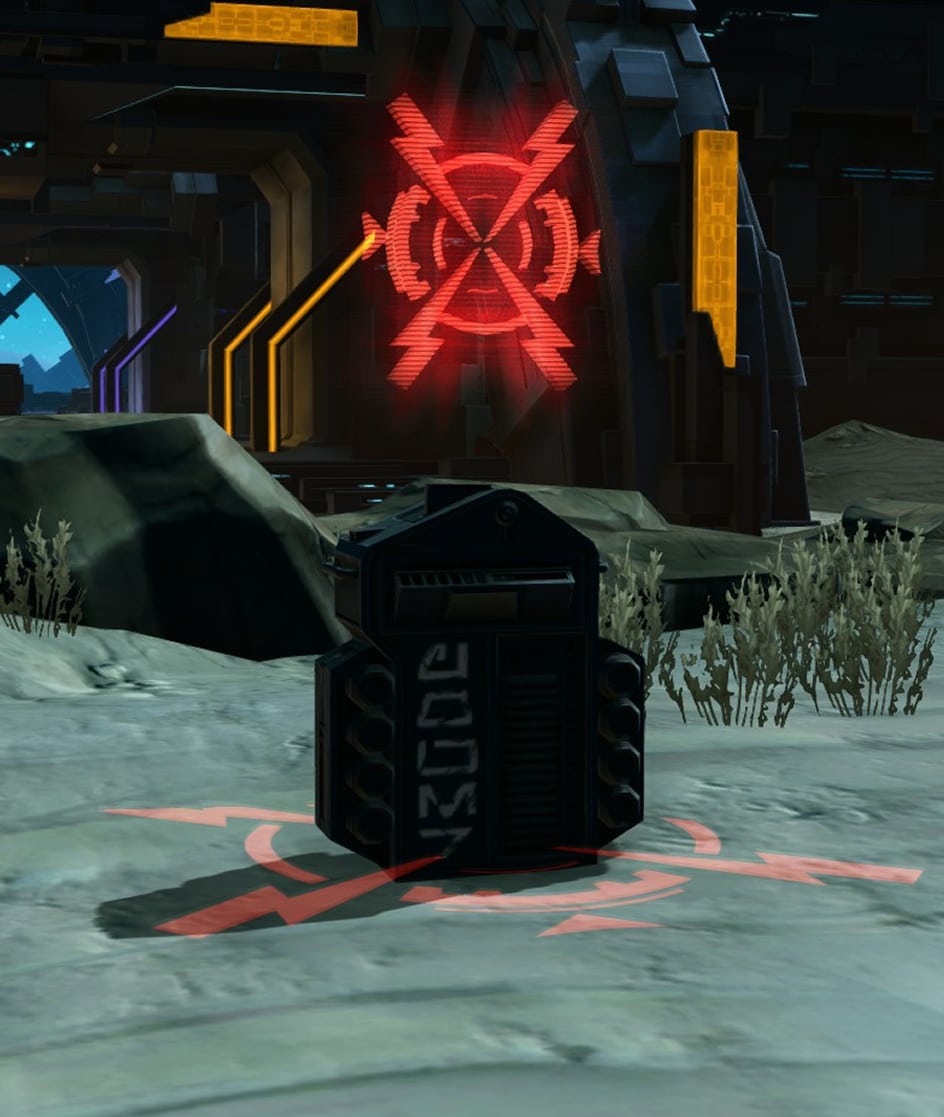
Movement Speed Buff:
This increases your running speed for a short duration. These are found in the side shelter zones beneath spawn points.
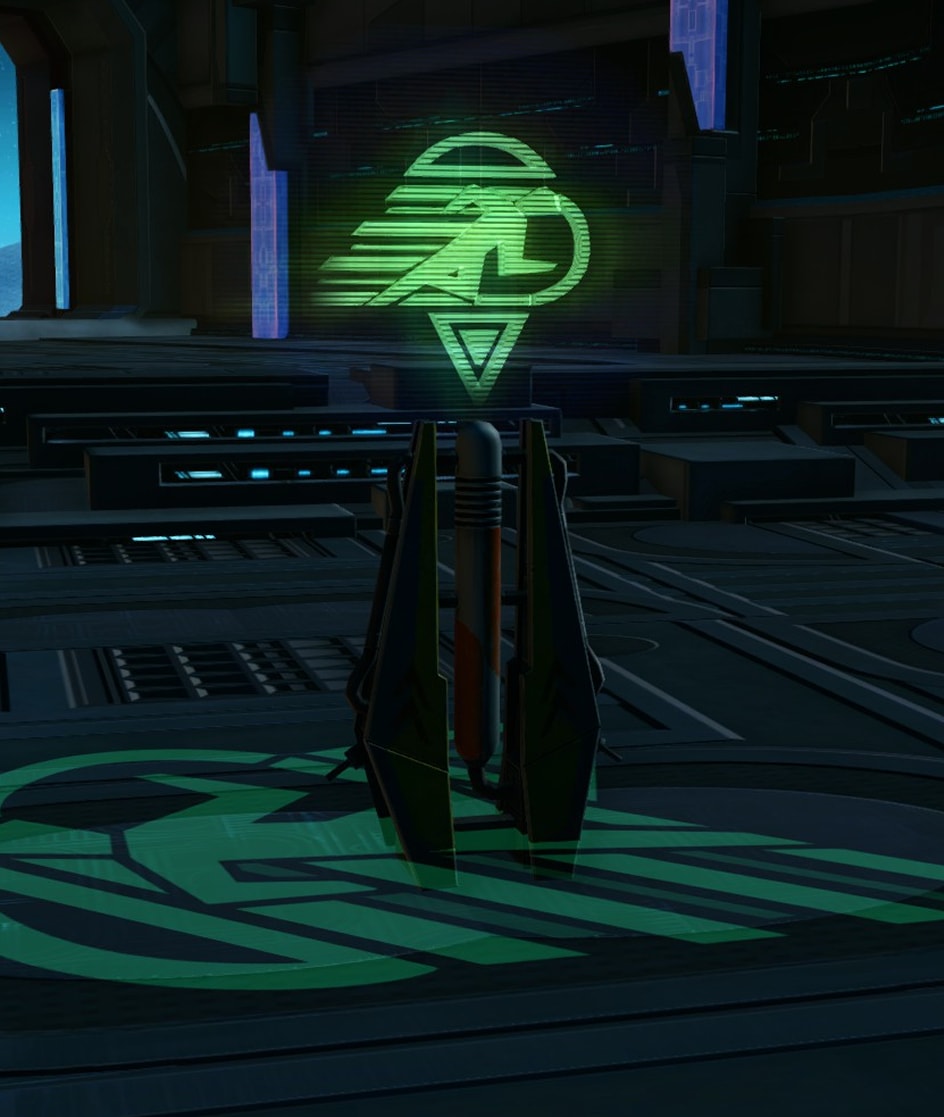
Energy Orb
Energy Orbs will increase a team’s potential points when brought to an allied pylon.
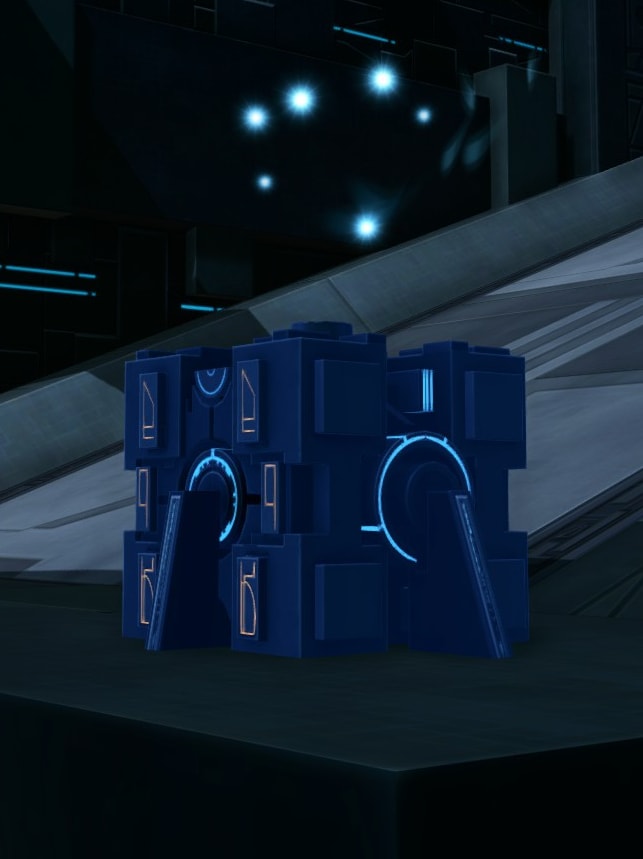
High Traffic Zone
This is where you’ll often see a lot of movement, typically of incoming enemies or allies. You’ll want your eyes on these areas as this is where enemies will be going to or coming from.
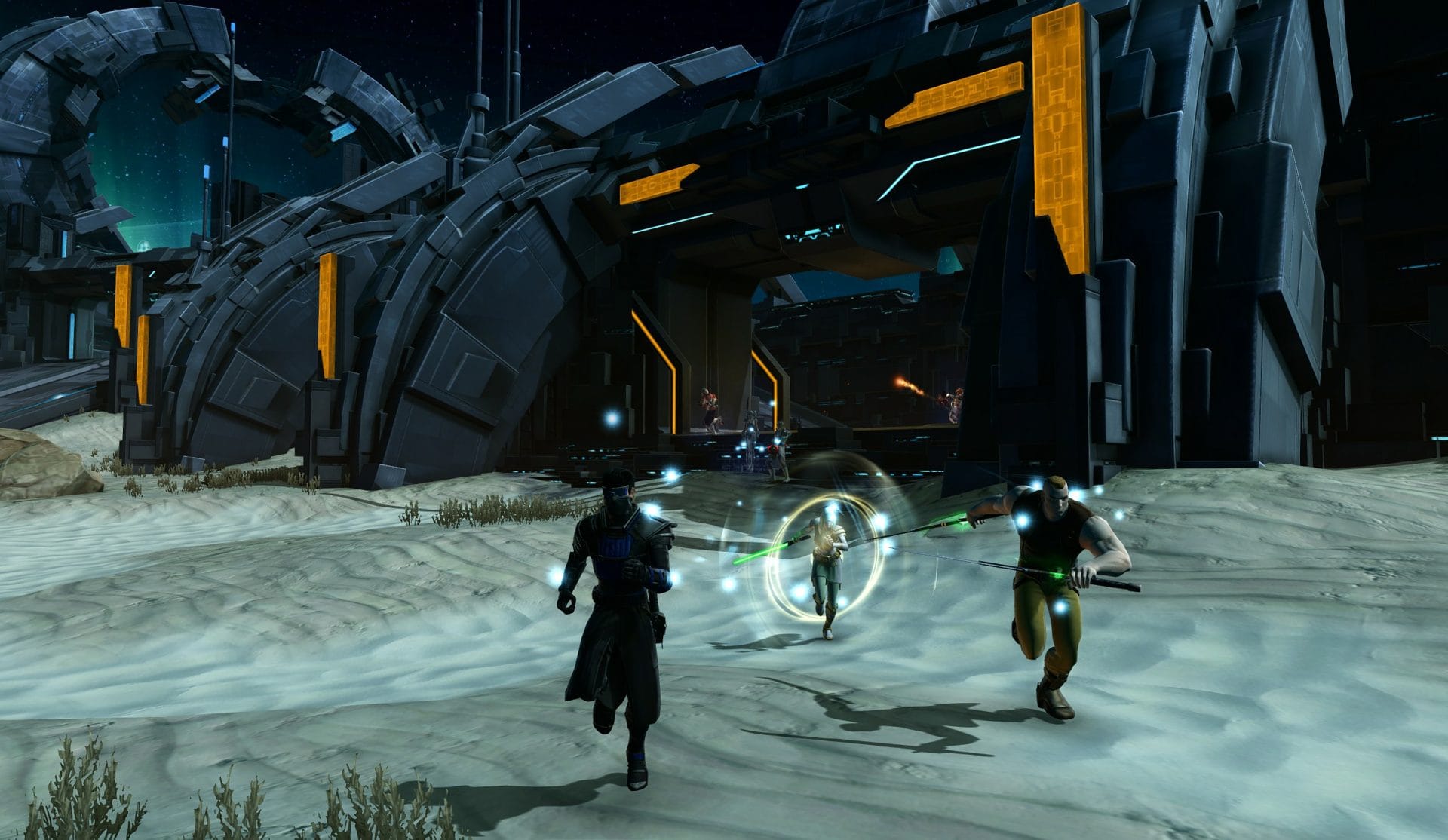
Points of Interest on the Ancient Hypergate Map
This section of the guide details some of the unique segments of the map that you may hear being referenced by other players and would be a good thing to know them before you venture ahead and join the game.
The Pylons
Below are the East and West Pylon zones, otherwise known as East and West. These are the areas that you will be attempting to gain control of during Ancient Hypergate.
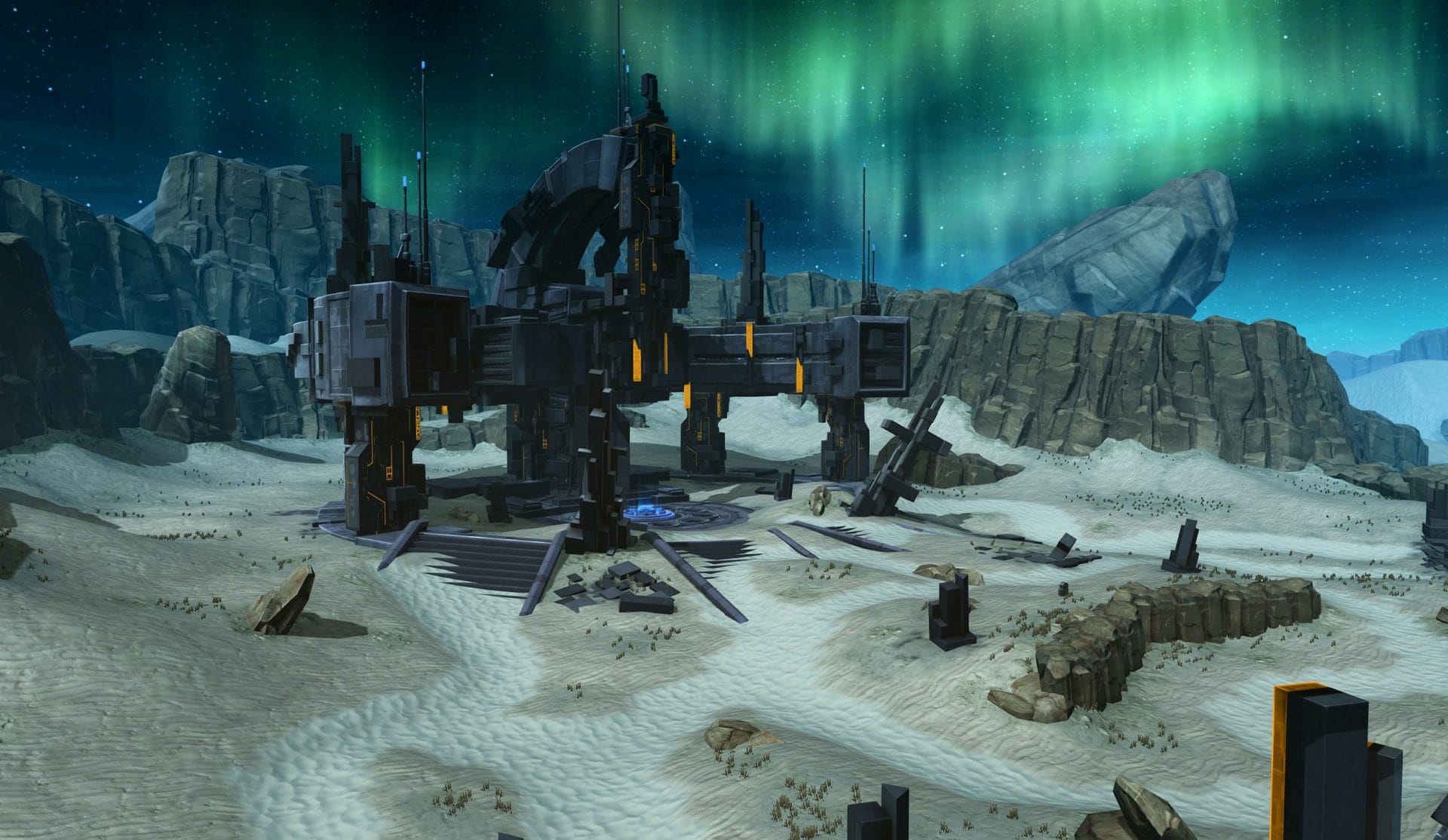
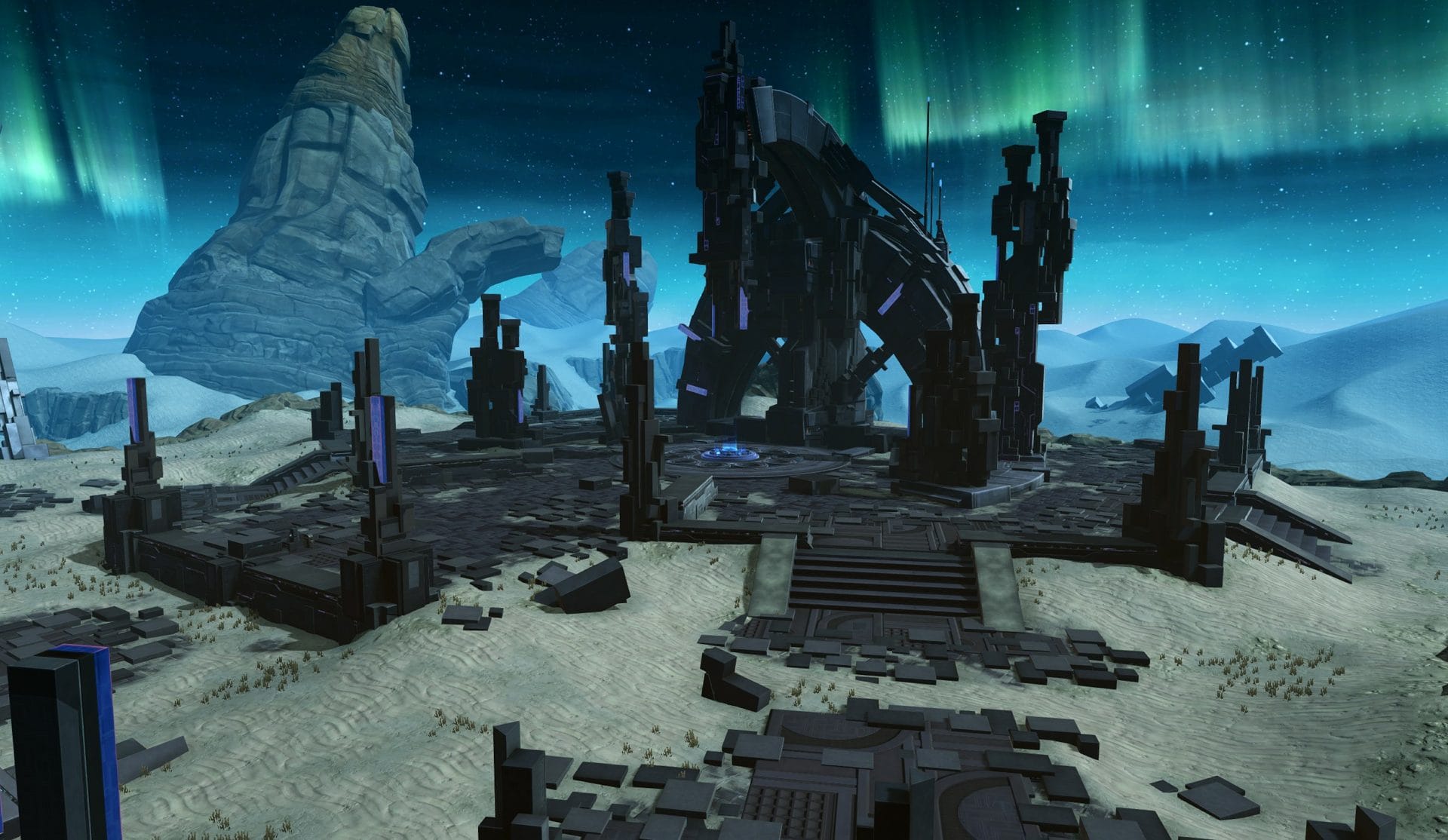
The Middle Zone
The Middle Center Zone, or “Mid”, is the part of the map that will see the most conflict as this is where teams will be competing for control of the energy orbs that spawn here.
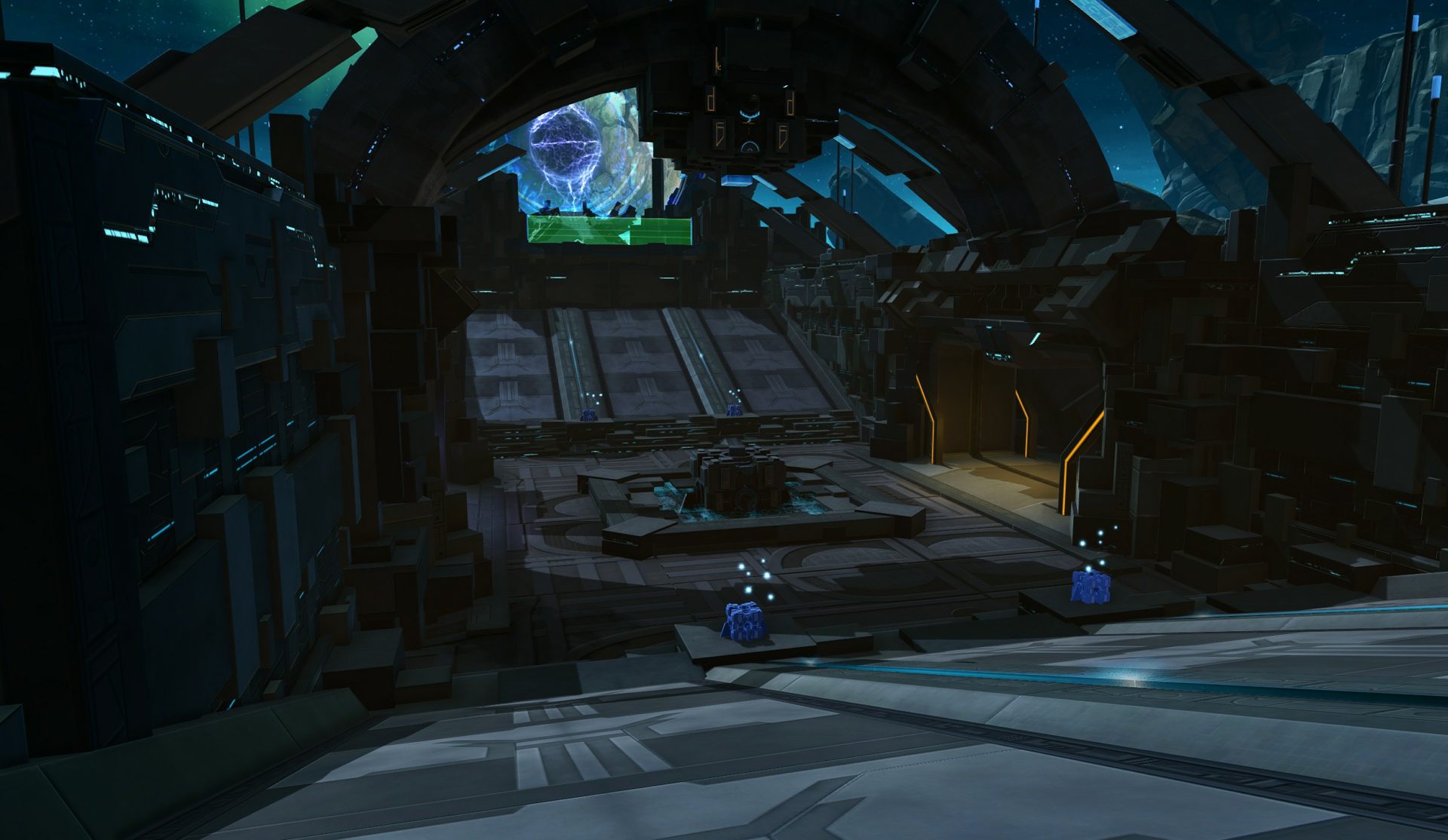
When the pylons detonate, a shield will appear at both entrances allowing anyone to pass through safely.
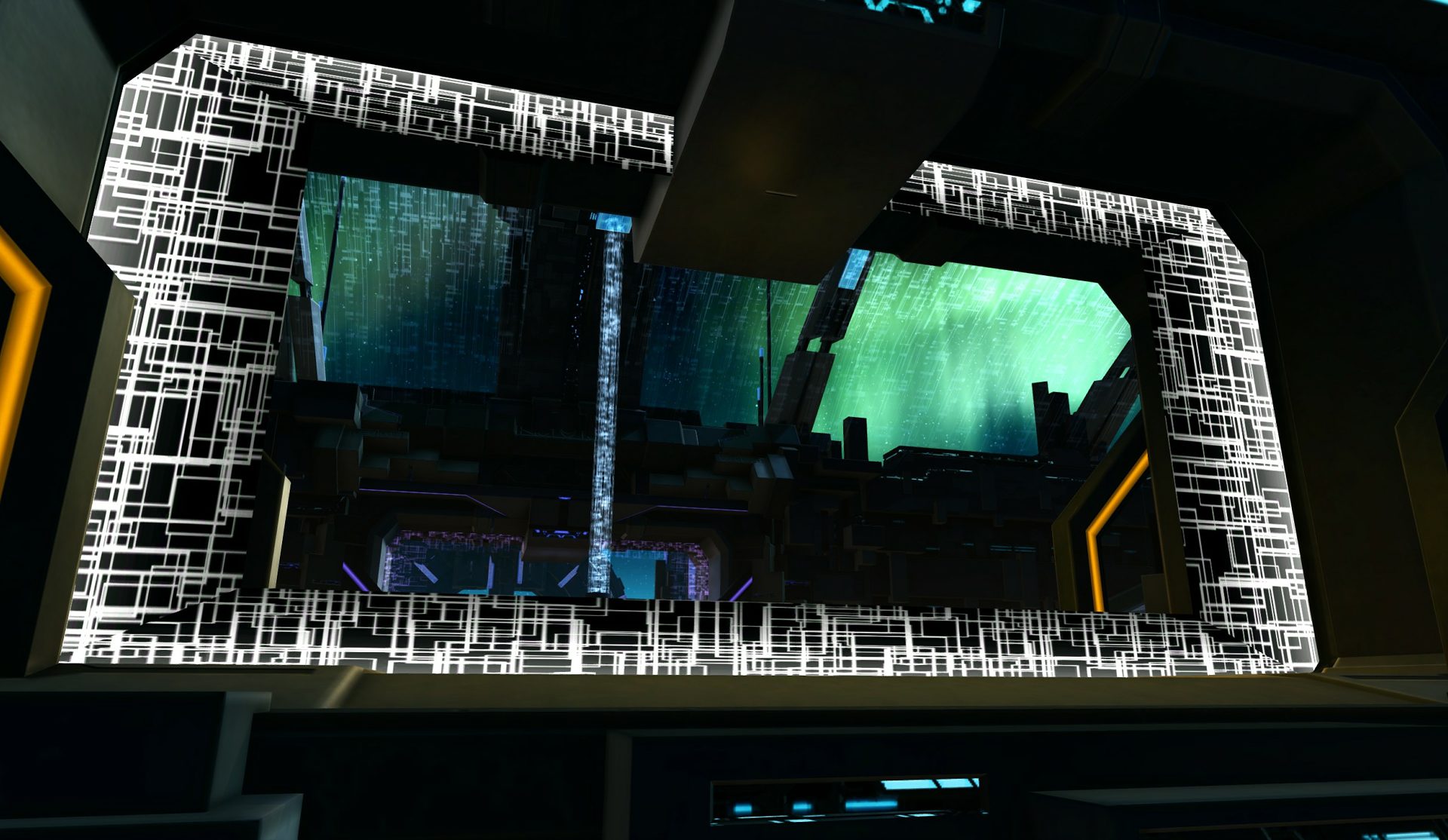
Side Shelter Zones
There are two shelter zones on the north and south parts of the map beneath team spawn zones, these are referred to as the Side Shelter Zones or Sides.

This can allow someone to walk around the middle shelter zone to access the pylons. Inside you’ll find a movement speed buff and at the end of the round as the pylons detonate, they will put up a shield that will not let anyone in or out until the pylons have finished detonating.
Teleport node location suggestions
Teleporting abilities such as Phasewalk, Hideout, and Hololocate are often used to gain distance from an opponent or to cut travel time. In the image above are location suggestions to put your teleportation node.
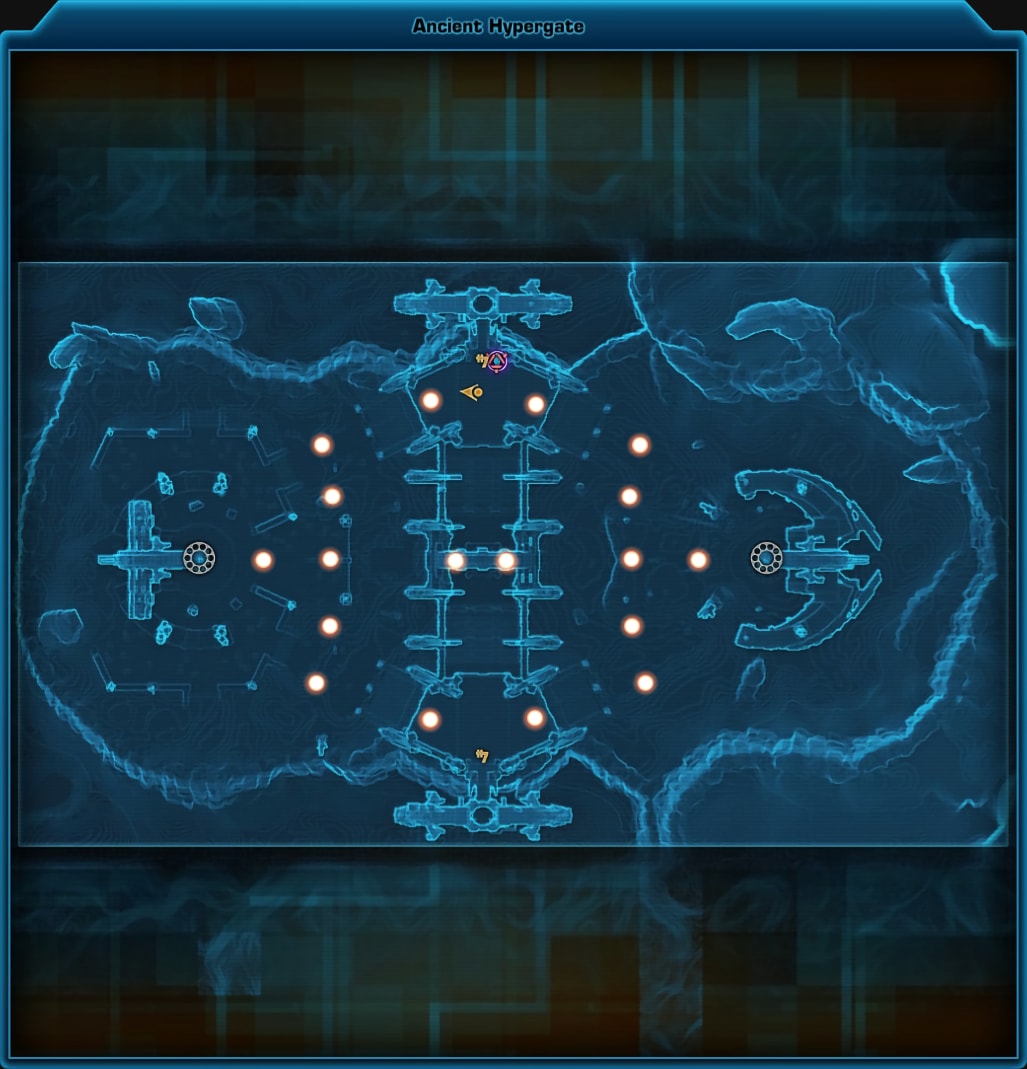
The location suggestions here are primarily used to cut travel time to reach a pylon or to seek shelter when the pylons detonate.
Placing a teleportation node near the warzone buff is a good way to cut off someone chasing you especially if they lack a dash to reach you.
Placing them in the side shelter zones will help you get into the shelter before the shield comes up while placing them in the middle shelter zone will help you get back inside in the event you are pushed out of them during detonation.
Role-Specific Tips and Recommendations
Some of the images in this segment of the guide are from the Rishi Stronghold PvP Area. They are used to more clearly and easily illustrate the scenarios and situations described below.
Tank Recommendations and Guard Swapping
As a tank, you should be doing one of two things. You’re either defending a pylon from invaders or you’re in a conflict zone such as the Middle Zone.

In either scenario, you should be guarding an ally that is nearby, typically one carrying orbs.
It is imperative to know how to swap Guard when fighting alongside two or more allies. To do this, you’ll need the Guard Ability set to something quick to access (I use the F key). Next you’ll need to open your Interface Editor to make sure the “Target of Target” window is enabled. This should allow you to see something like this:

Nadia is looking at me and her target (me) is on the far right. This is what the “Target of Target” window enables. So if you’re in a battlefield, you can press Tab to swap enemy targets in front of you to see who they’re targeting.
If the enemy is someone like a Sentinel/Marauder, Shadow/Assassin, or other enemies that can deal high damage to your ally, you need to guard the ally they are targeting.
The fastest way to do this is to set a hotkey to acquire the target of your target. To set this hotkey, go to Preferences > Key Bindings > Targeting and scroll down until you find “Acquire Target’s Target”. Set the key to something you can quickly and easily access (I use the `~ key, the one right next to the 1 key). Now you have no excuse to NOT protect your allies in an efficient manner!
Stay within 15 meters of your guarded ally so their damage is reduced by 50%. The other 50% of that damage will be transferred to you. This damage can be reduced through your tank stats such as Damage Reduction, Defense Chance, and Shield Chance! Guard Damage will break Stealth.
The enemy group will likely begin to focus on another target that you aren’t guarding. It is then your responsibility to find out who they’re focusing next, target their target, and guard that ally and repeat this process as necessary. The ability to Guard Swap is one of the core skills that separates the bad tanks from the good tanks in PvP alongside DCD timing and Resolve Bar management.
DPS Recommendations
Your job is simple, you just kill the enemy team to allow your team to secure a pylon. Though it’s not as simple as it may seem, anyone can fire blaster bolts at someone all willy-nilly.
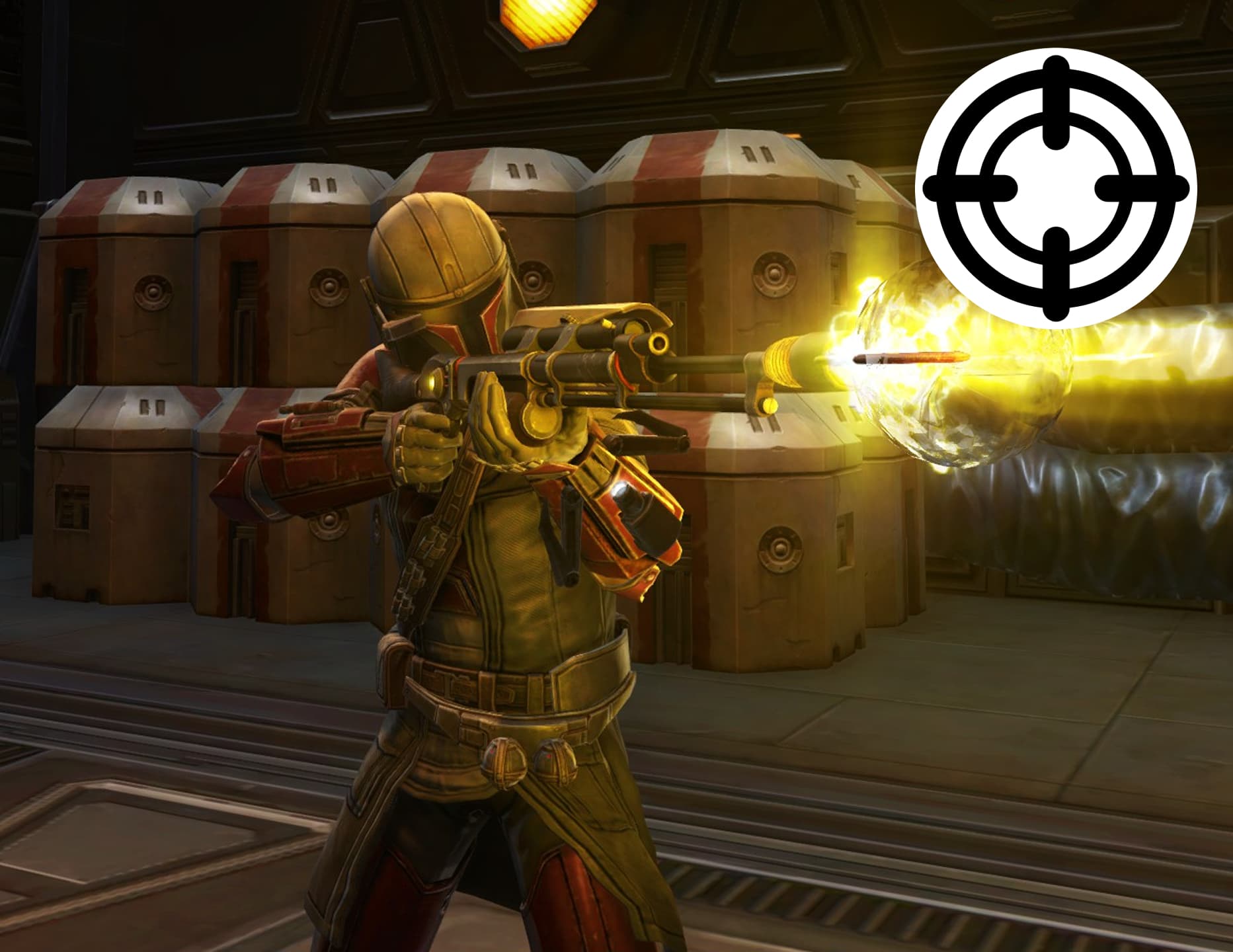
You must focus your fire on priority targets such as enemies carrying energy orbs, healers or squishier DPS units such as Sages, Sorcerers, DPS Shadows and Assassins, and DPS Vanguards and Powertechs.
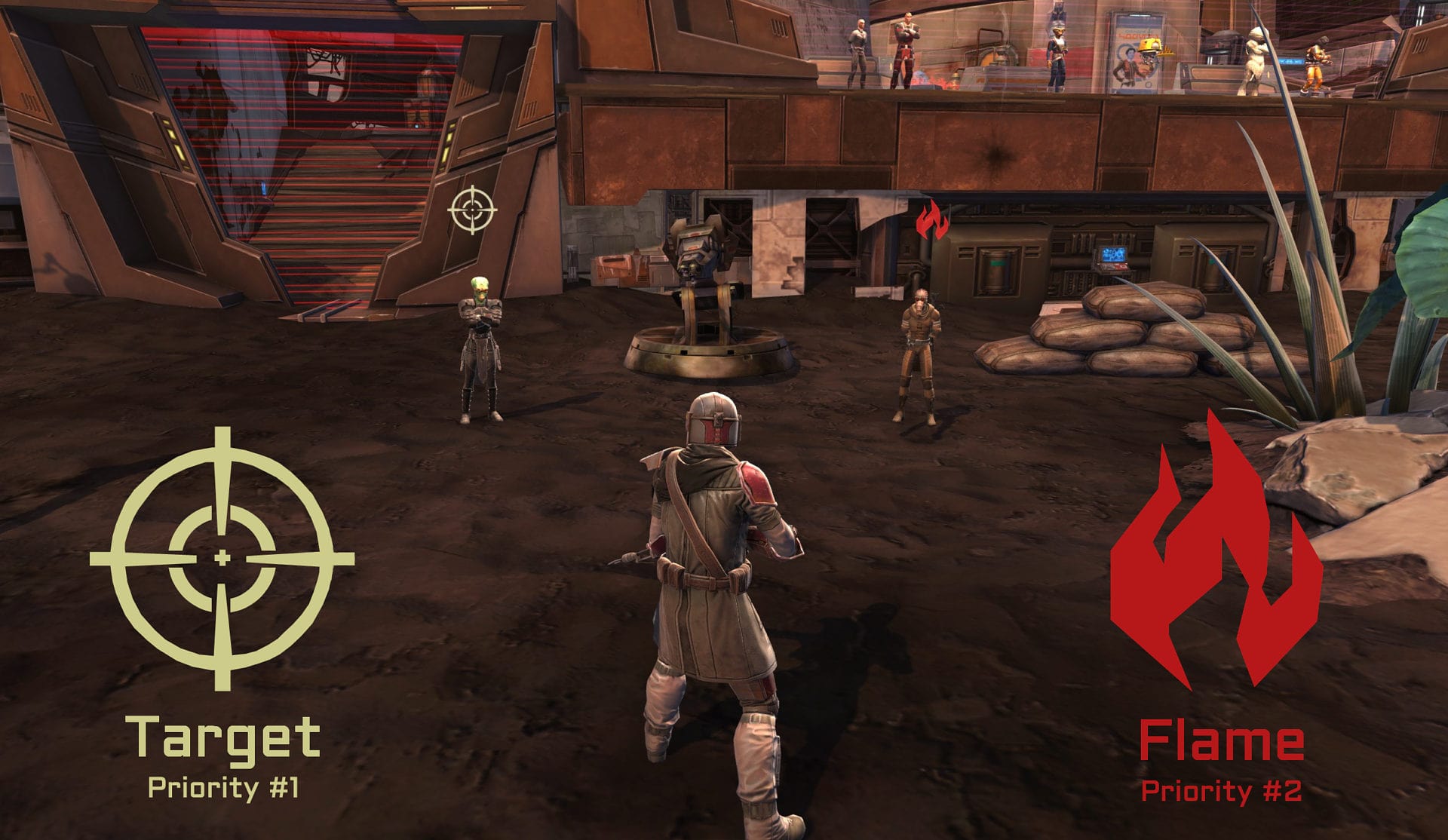
Utilize target markers to show teammates which target they should prioritize on. Typically a target with the Target symbol above their head takes first priority while a target with the Flame symbol above their head takes second priority.
Support Recommendations
Every combat style can provide support in some form or another as there is no dedicated support class outside of healers. Speaking of healers, you just need to heal your allies as usual with your priority being the tank if you have one (who should be guarding you).
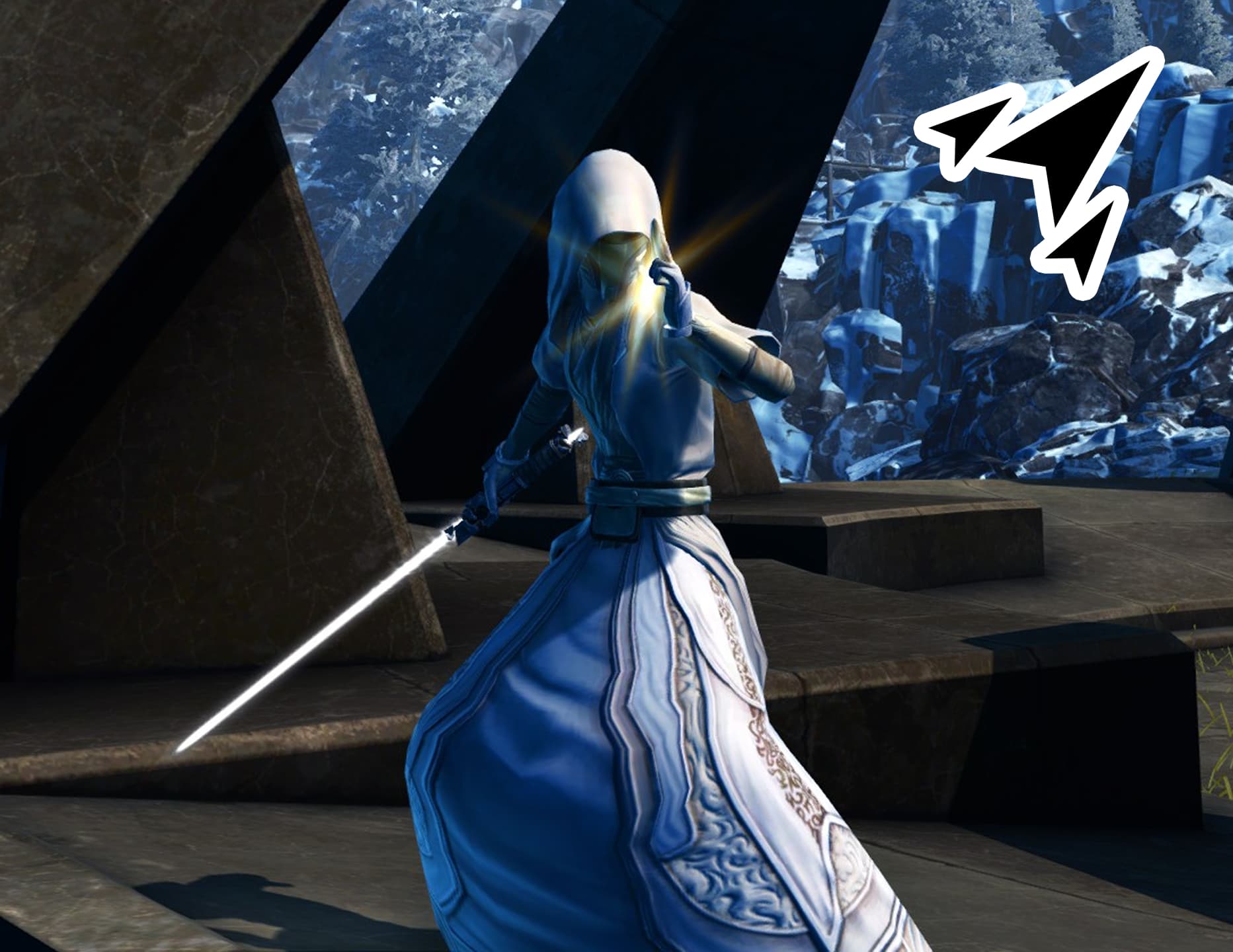
Should all of your allied DPS fall in combat, you and the tank should have the means to stall hopefully long enough so your allies can respawn and run back.
Let’s look at some of the many unique abilities among combat styles that offer great support for their team.
Sentinels/Marauders with access to the Transcendence/Predation ability are great to have at the start of the match.
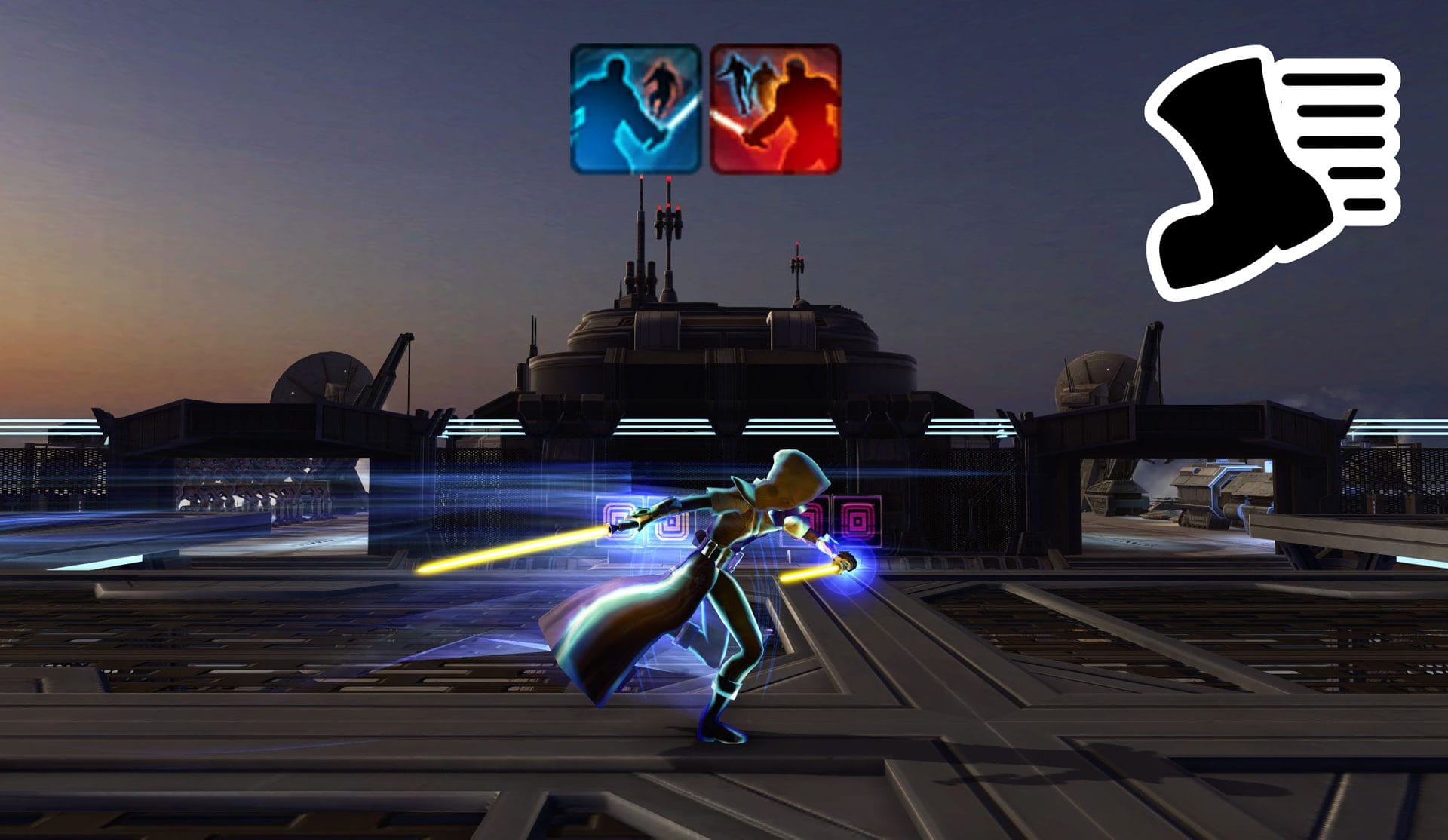
When used, this ability grants group members within 40 meters 80% more movement speed, 10% increased defense chance and purges movement impairing effects such as slows. This is great to use to help everyone reach the control points sooner and hopefully secure them before the enemy does.
Gunslingers/Snipers have access to a great ability called Scrambling Field/Ballistic ShIeld.
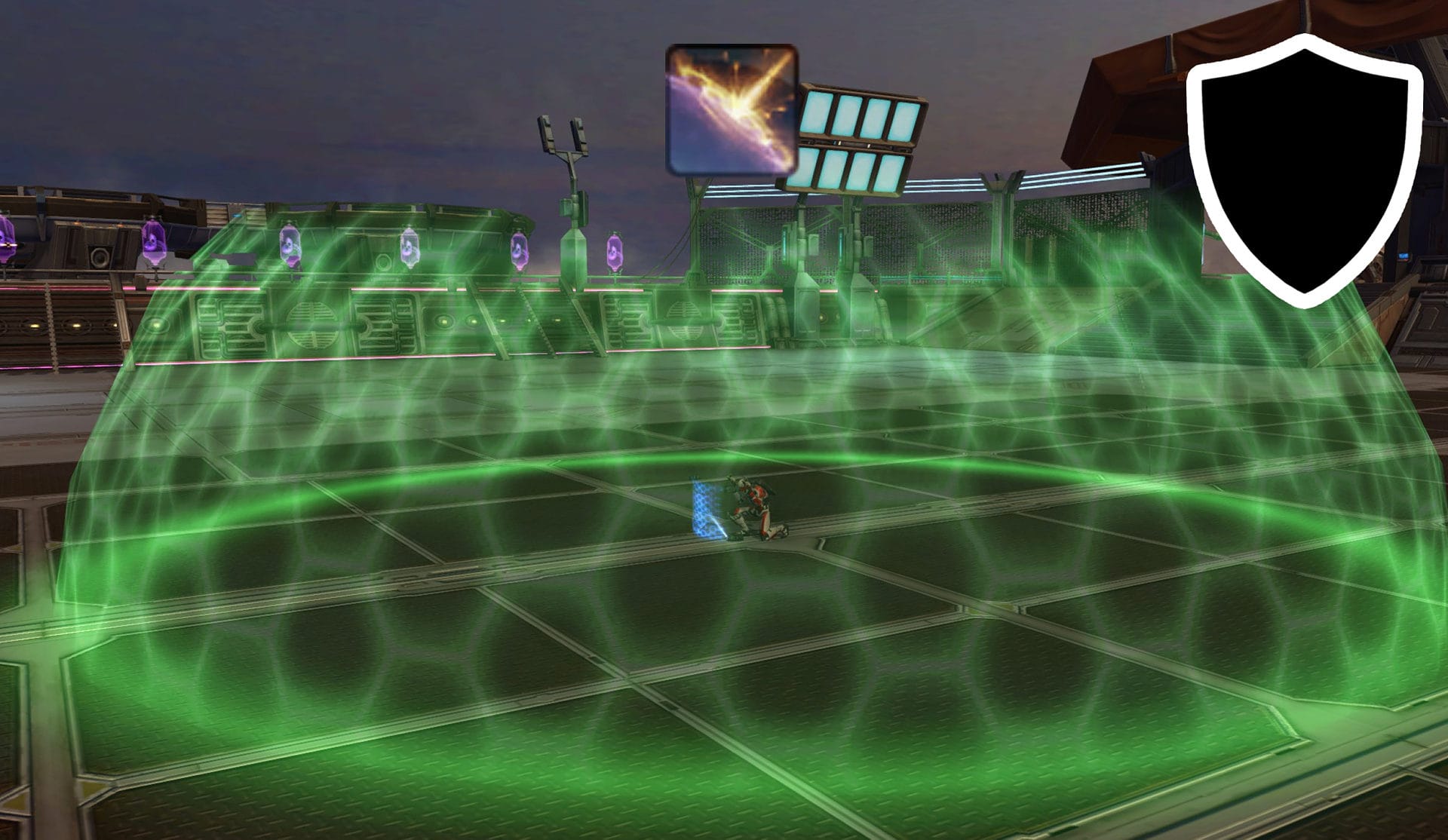
This creates a circular area with a 10 meter radius that reduces damage done to allies within the area by 20% for 20 seconds. With a 3 minute cooldown, this should be used wisely and during times when combat is very intense.
Stealth Scan is an ability that Troopers and Bounty Hunters can gain access to. When used, probe droids will scan an area for 15 seconds, detecting any enemy stealth units. If an enemy stealth unit is caught, they’ll be immobilized for 3 seconds.
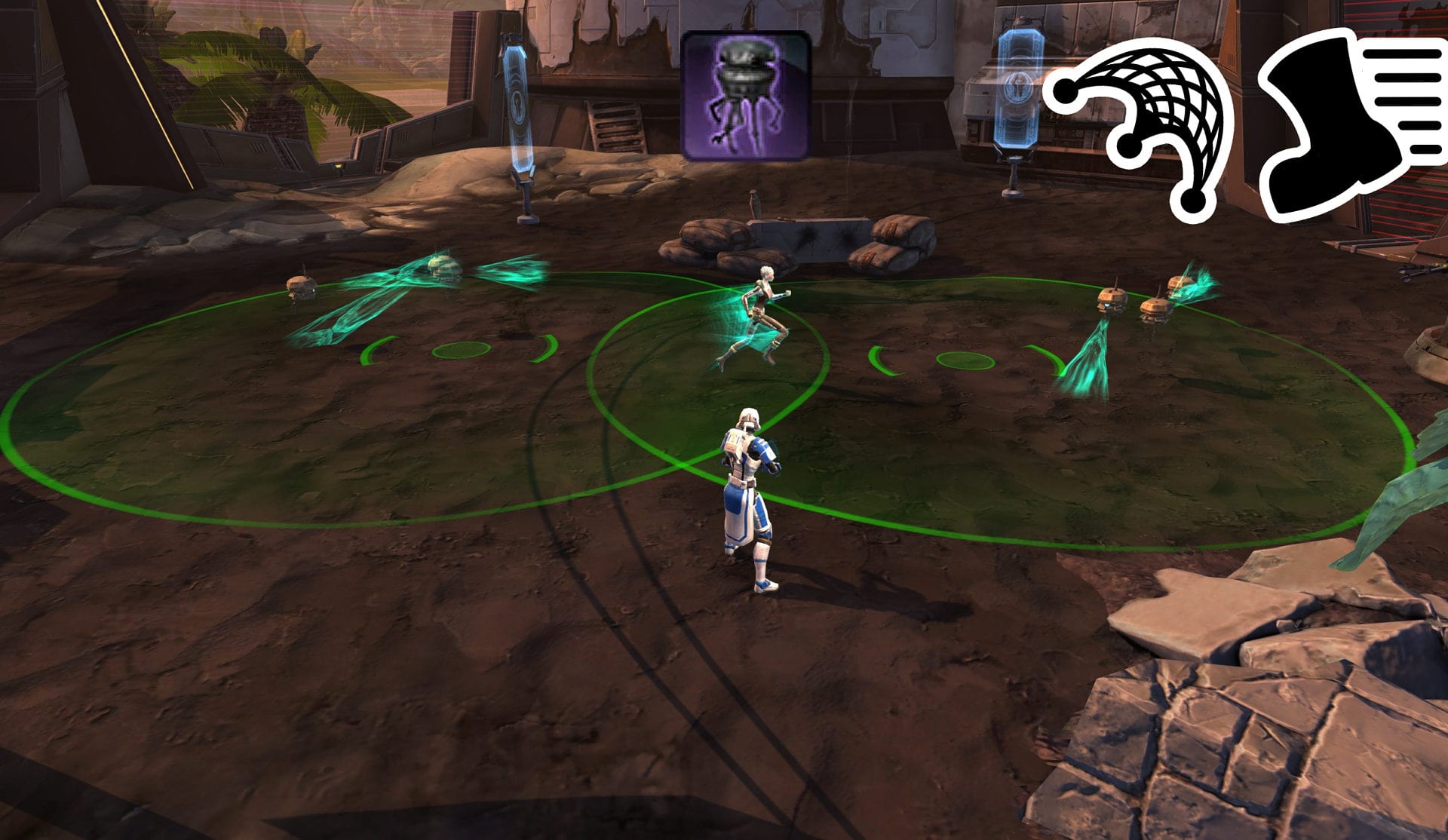
Allies within the area also gain 50% movement speed so long as they remain within it but will keep the effect for 6 seconds if they leave the area. This ability is great to use right after a stealth unit uses their combat stealth to disappear mid-combat.
Catching them will throw them off and ruin their momentum. Since this is on a 10 second cooldown with a 15 second duration, Stealth Scan can have a 100% uptime in an area. You can even link the two zones to increase the area where allies get increased movement speed.
If your combat style has access to an area ability that can be cast at a specific point, then you must keep an eye on the pylon if you’re fighting near one.
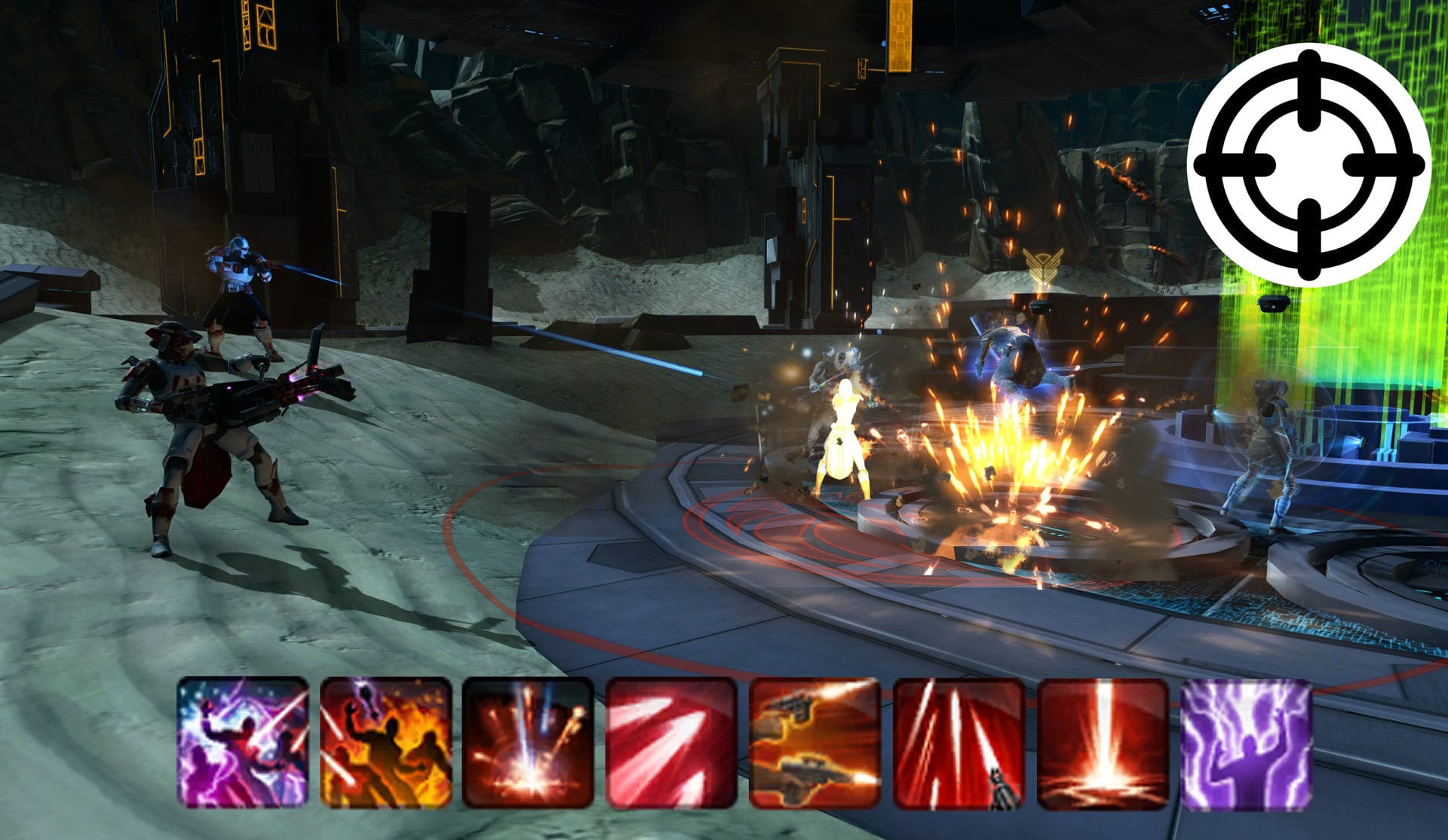
Oftentimes someone attempting to capture one will hide behind the point to avoid targeted abilities. Area abilities will ignore this so casting this on top of the pylon will stop someone in the middle of capturing it. Direct damage AoEs are needed to stop a channel so indirect damage AoEs will not stop the channel.
Stealth Recommendations
Stealth units have the luxury of entering combat on their terms. In Ancient Hypergate, their job is to act as recon, capture pylons, and/or dispatch priority targets in group combat.
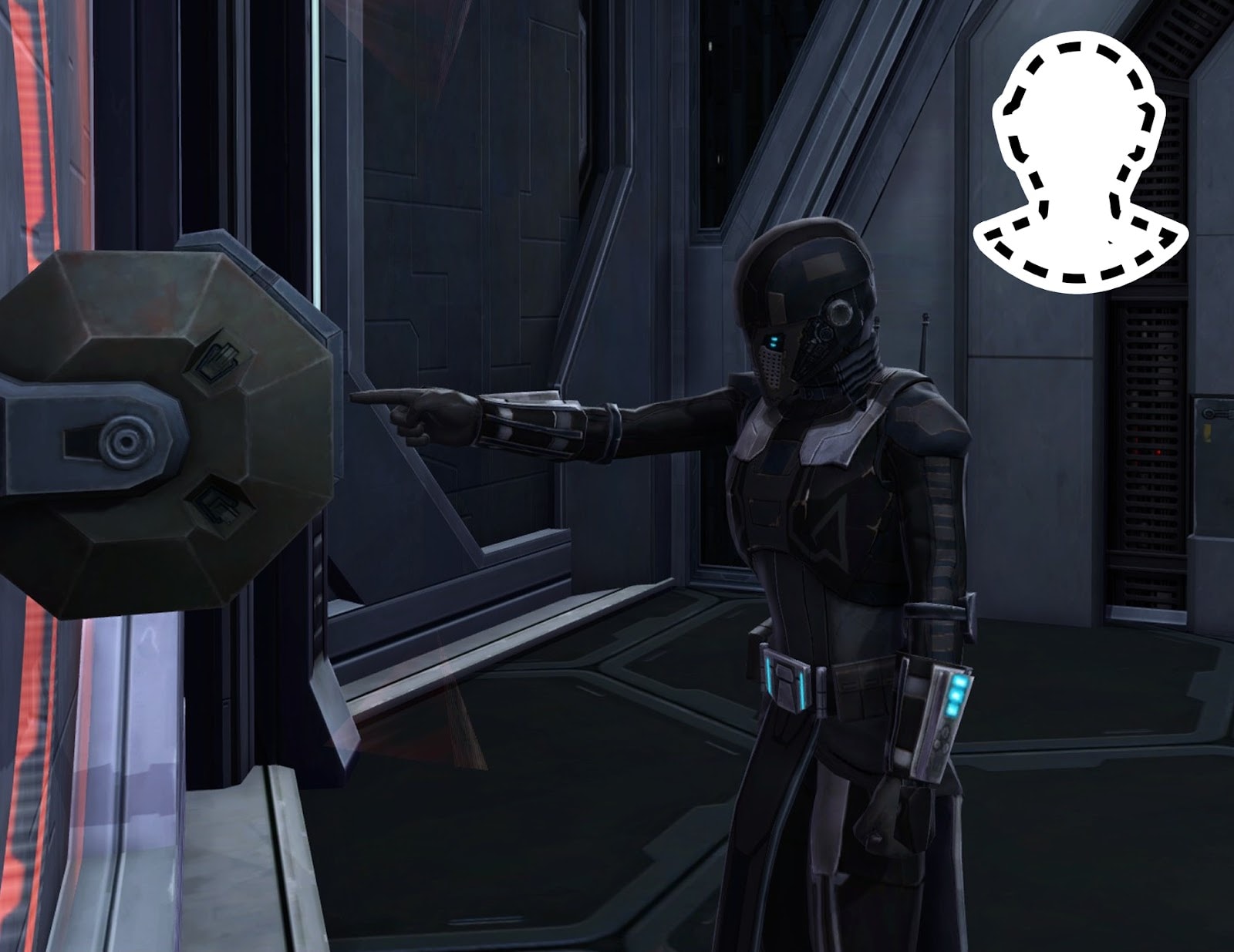
Non-stealth units will find it difficult to type in the midst of combat, meanwhile stealth units can tell their team about enemy movement while hidden away. While providing recon is important for your team, don’t let it be the only thing you do. Contribute to your team’s efforts by participating in group fights or capturing enemy pylons.
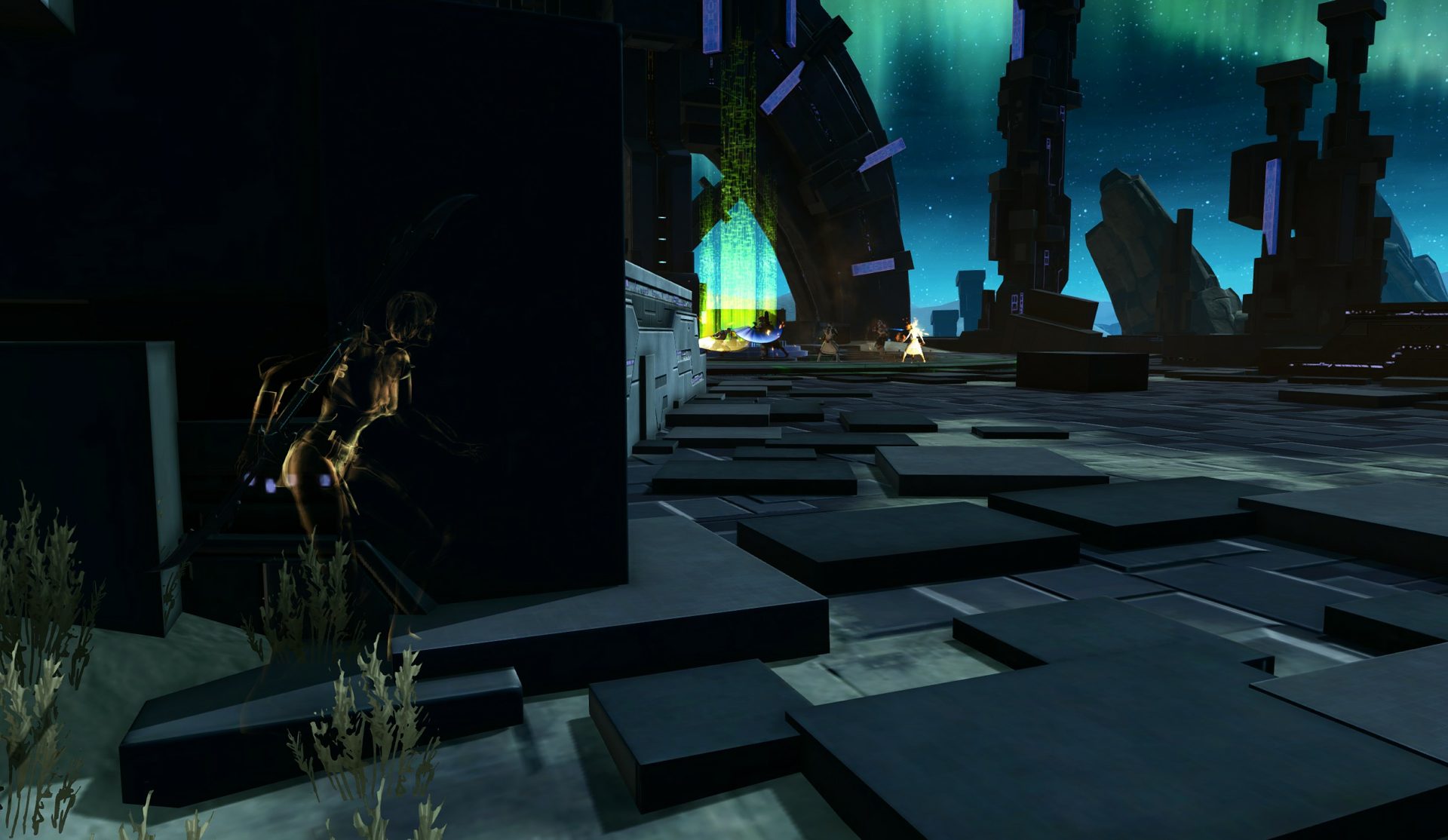
Communication is an important task for any stealth unit to perform. While they have the ability to type safely while cloaked, they should learn to abbreviate their words to cut down on their time typing. Here are some common abbreviations and terms used for PvP communication:
- DPS = Damage Per Second, typically to refer to a damage focused player.
- Tank = A player who focuses on defense, typically tough to kill
- Heals/Healer = A player who focuses on healing other players, they are
- AoE = Area of Effect, typically a damaging ability that hits several targets in an area.
- CD = Cooldown
- DCD = Defensive Cooldown
- GCD = Global Cooldown
- CC = Crowd Control
- Mez/Mes = Mesmerize stun, typically lasts 8 seconds and breaks on damage taken.
- Sap/Sleep = A mesmerize stun used from stealth
- Rez/Res = Revive
- Omw = On my way
- Cap = Someone attempting to capture an objective
- MVP = Most Valuable Player
- Thrower = Someone who is intentionally throwing a match
- Farming/Inting = The act of intentionally getting killed to help the enemy team
- Carrying = The act of helping a team member or the whole team to win when they would not have been able to otherwise.
- Pocket Healer = A healer who only heals one person, typically someone who queued with that player.
How to Guard a Pylon
What separates the good pylon guards from the bad pylon guards? Vigilance, discipline, communication, and knowledge. This role is a very important one and sometimes, not the most exciting one, but one that should be filled regardless of the situation.
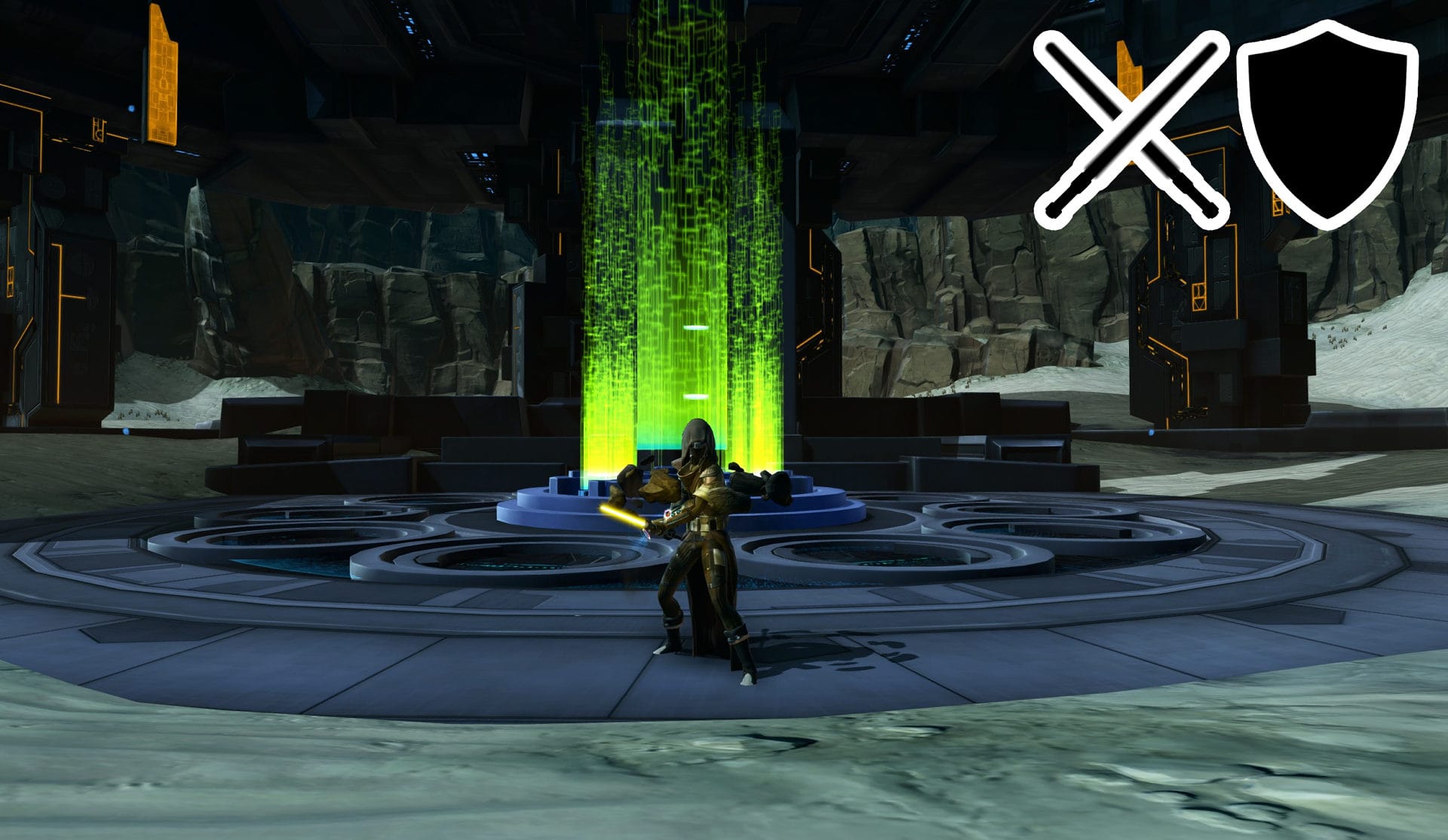
More often than not, the pylon guard will end up having to fight a lot of 1v1s during their duties. Due to this, it is very important for them to know their rotations and how to use their abilities against certain enemies. Let’s go over the various aspects of guarding a purret.
Lookout Duties and Communication
When you guard a pylon, you must keep your eyes on the high-traffic zones as that’s where enemies will come from. This can be seen as the most boring aspect of the job by many but it is by far the most important one.
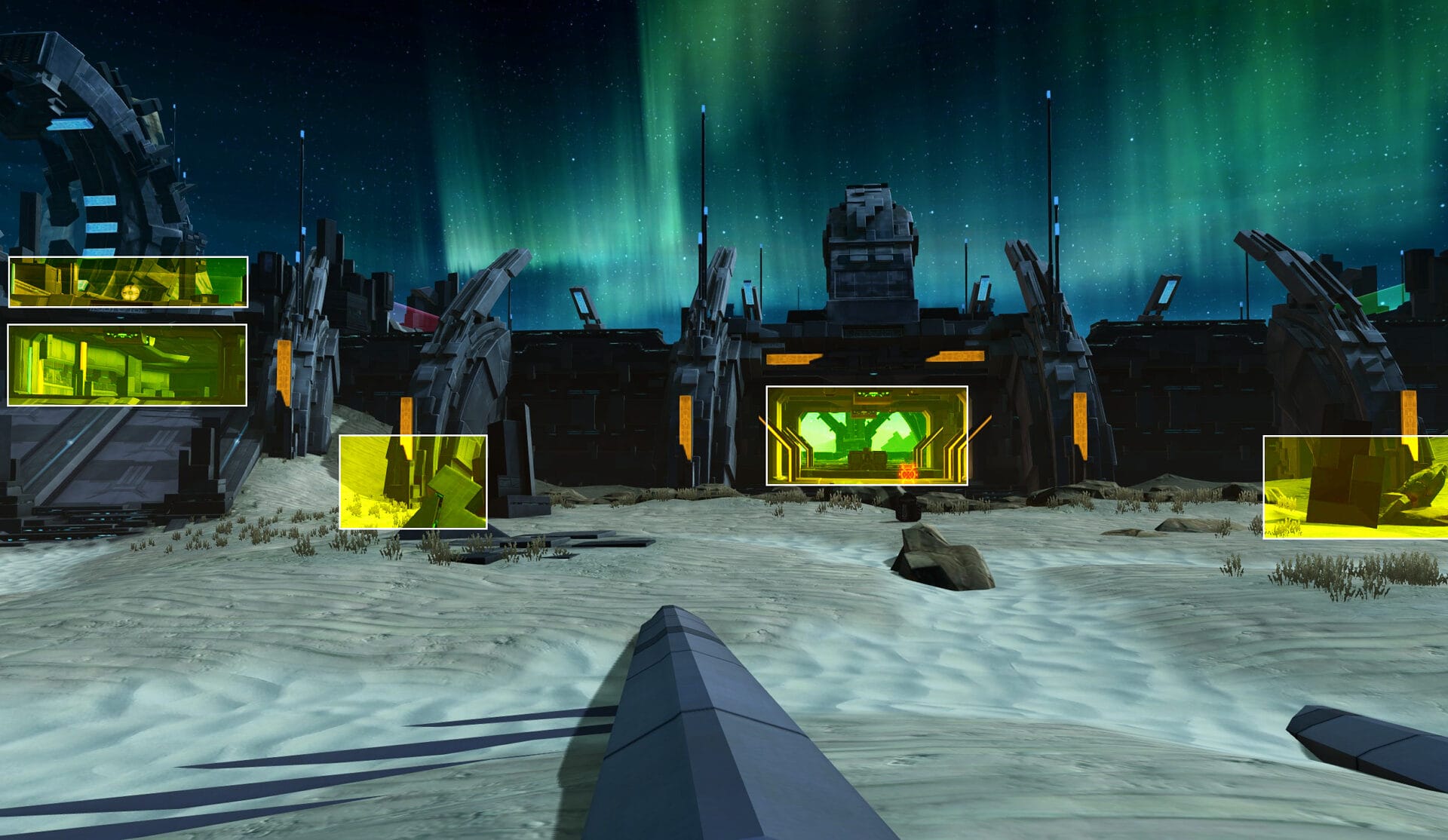
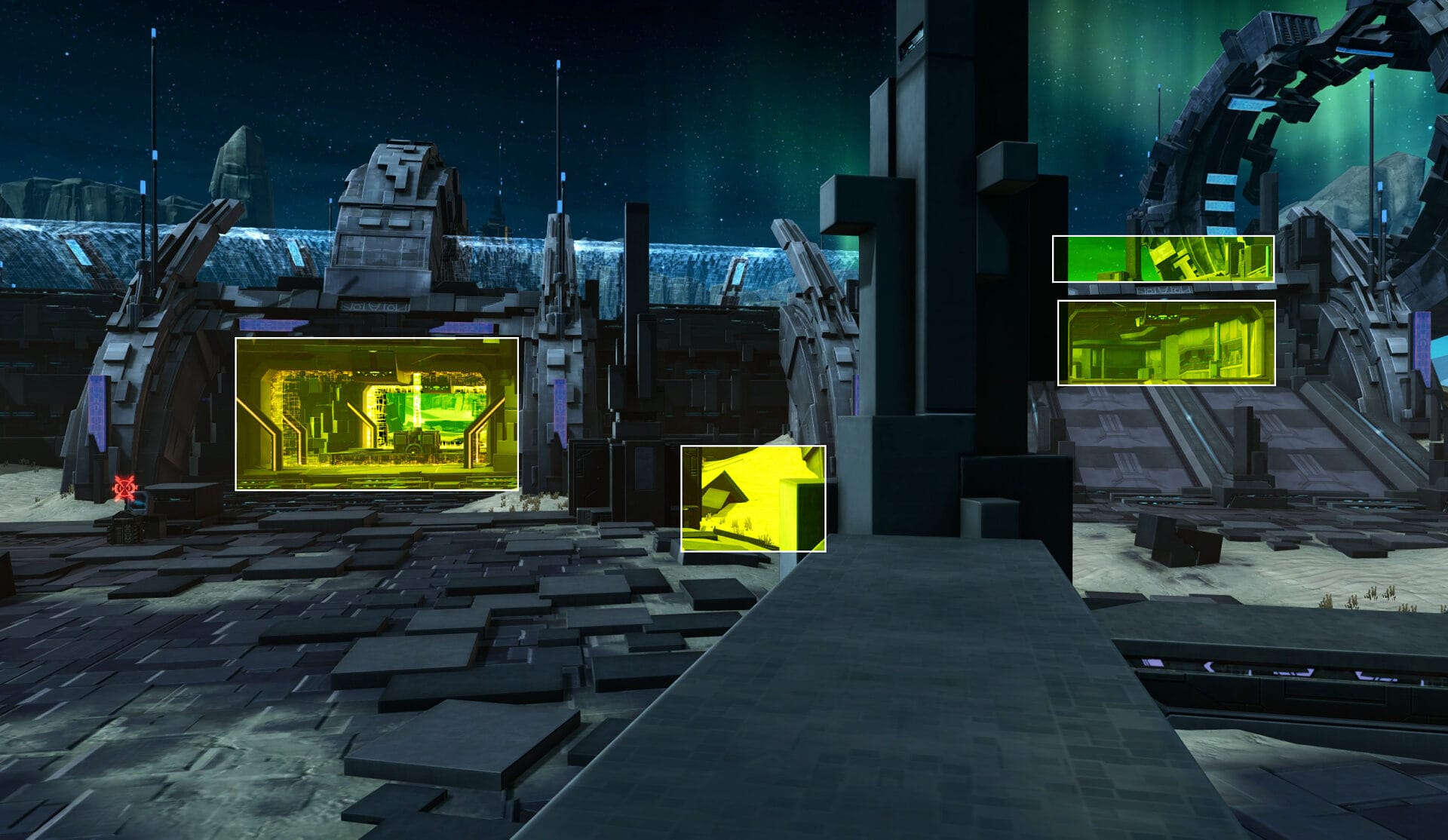
In the images above you can see highlighted areas in the images above. These areas are where you want to keep your eye on for incoming enemies.
The moment you see an enemy coming, you need to type to your group how many are going to where. Fortunately there aren’t many places for the enemy to come from so keep an eye out at the middle shelter zone, the side shelter zones, and the enemy spawn point. Let’s use an example scenario.
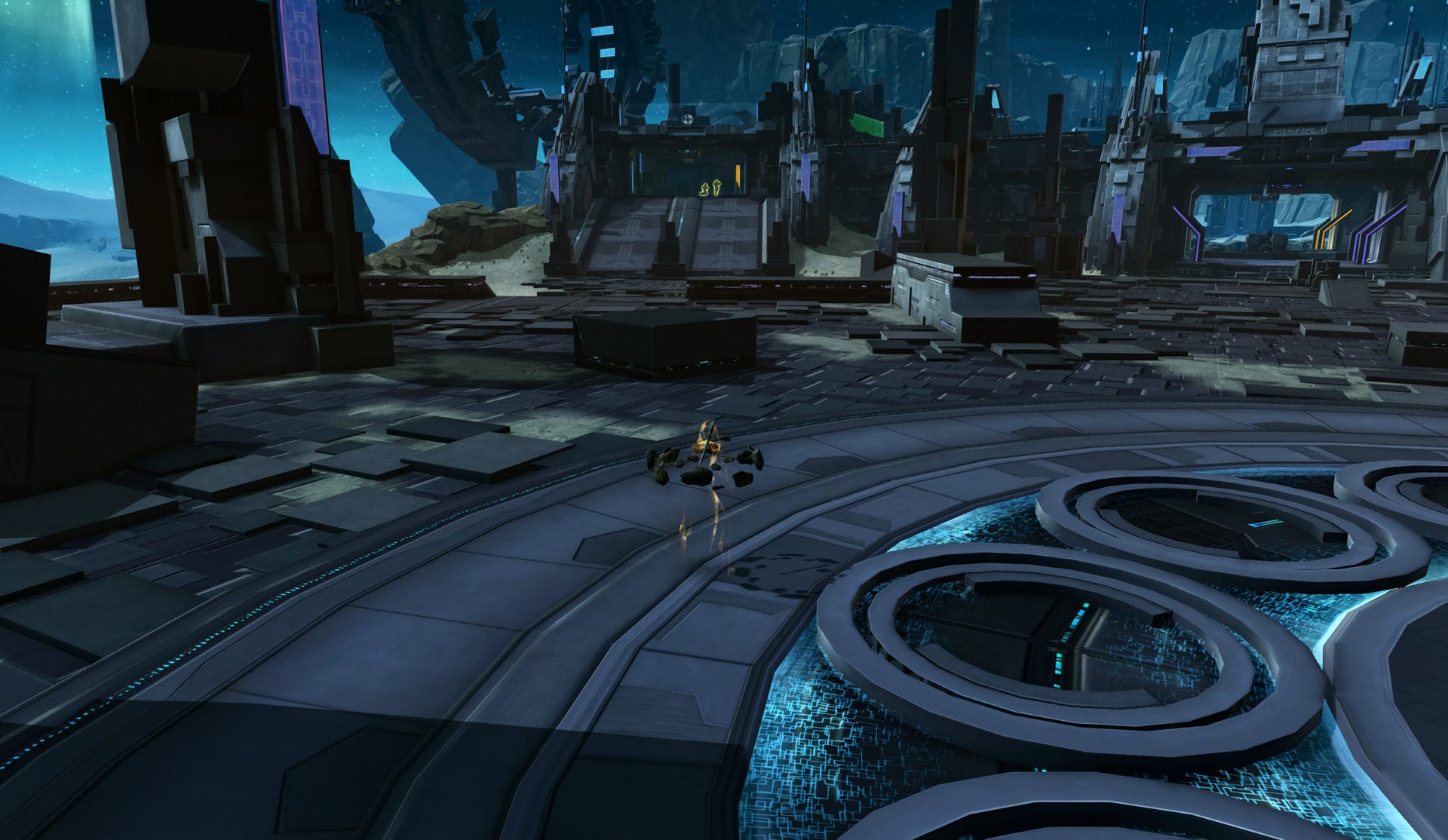
You’re at the West pylon and you see 2 enemy players (highlighted yellow in the image above) coming from the side shelter zone. What do you type to your team?
While you could say “We got 2 enemies incoming to the west pylon”, it’s inefficient. Instead you must summarize that to something like “2 inc west” or “2 INC WEST”.
Whether or not you use caps or not is up to you, just limit the caps to recon chat remarks and not standard chat. This allows your team to quickly know how many are coming west and how many to send your way, in this case at least 2 people.
If you were to just say “INC WEST”, this can cause your team to overreact and send the whole team there leaving the energy orbs or a contested pylon alone only to find out there were 2 invaders at West. Use your nouns and adjectives when typing because people can’t read your minds and often lack map awareness.
Do not be one of those people who doesn’t state incoming or states incoming after they died or about to die. You must be proactive with your lookout duties to ensure the best odds at maintaining control of your pylon.
Spacing
What is spacing? Spacing is your ability to keep your distance from your opponent when necessary. Why is this important? To deal with mesmerizes and incapacitated.
More often than not, the type of enemy that will be attempting to capture a pylon from you will be a stealth unit. They have access to a stealth mesmerize which will leave you unable to act for 8 seconds, this is just enough time to allow them to capture the pylon.

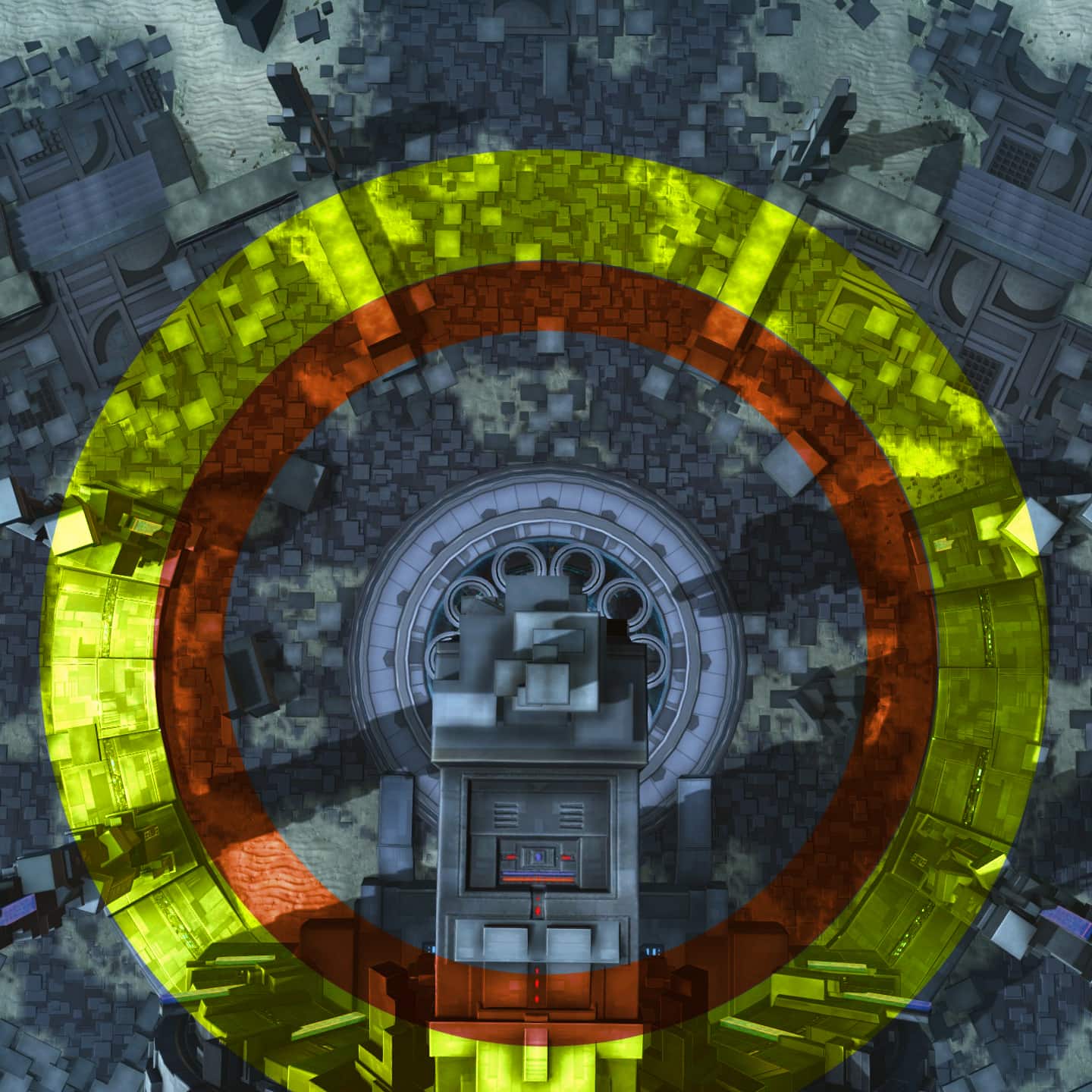
In the images above are highlighted zones, these are the areas in which you want to stand in. You’ll notice two zones, yellow and orange. Due to this area being rather wide and open, where you’ll stand depends on the range of your abilities.
If you can attack from 30 meters or way, stick within the yellow zone. If you have more medium or shorter ranged abilities, you might want to stick with the orange zone. But use more caution as this closes the distance between you and the pylon for the opponent allowing for shorter travel time for a capper.
Standing out here will make the enemy spend a second or two running to get to the point if they incapacitate you, leaving you a second or two to react once the mesmerize wears off.
If they’re very dedicated towards capturing your pylon, they’ll have a backup incapacitate that can be used out of stealth. Spacing is very important so you can use that second or two to react in order to save your CC breaker ability for this second incapacitate. If you use it on the first, this makes you unable to get out of the second allowing them to capture the pylon with ease.
A common trick enemies will use is to hide behind the pylon control point opposite of the pylon’s guard. This prevents the guard from using any targeted abilities to stop their channel.
Area abilities are a good way to get around this but if you lack a point and click area ability, a good substitute is to use the various V-9 Grenades made by Cybertech crafters.

I would recommend the V-9 Cartel Waste Grenade. These will deal the damage you need to stop a channel and not fill their Resolve Bar, all while slowing them by 70% for 9 seconds. This will allow you to fill their resolve bar with your own CC as you see fit. Any of the Cybertech grenades work except the V-9 Pyro Grenade. That grenade deals indirect damage over time and will fail to stop someone from capturing the pylon. Keep in mind that the grenades share a cooldown of 3 minutes, so if you use one you can’t use the others until the cooldown is finished.
Number of Guards
A common mistake people make is leaving too many people guarding a pylon that doesn’t have a lot of activity at the moment. For the most part you only need one person guarding the pylon.

This job is best suited for someone who has high durability, great dueling potential, stealth, or stealth detection.
Having unnecessary guards, leaves the other players participating in group combat at a disadvantage as they will be left outnumbered. In some instances, however, you can have at maximum two guards if the other six players are competent and able to control the middle shelter zone.
Though I would only recommend doing so if these two guards lack stealth or durability. Otherwise don’t be selfish and leave your team outnumbered because you think guarding a pylon is “easy”.
Stalling and Sacrifice
If you find yourself outnumbered and waiting for reinforcements, focus less on trying to defeat your opponents and more on surviving for as long as you can. At one point or another during your duties as a pylon guard, you’re going to run into a situation with you having zero odds of surviving.
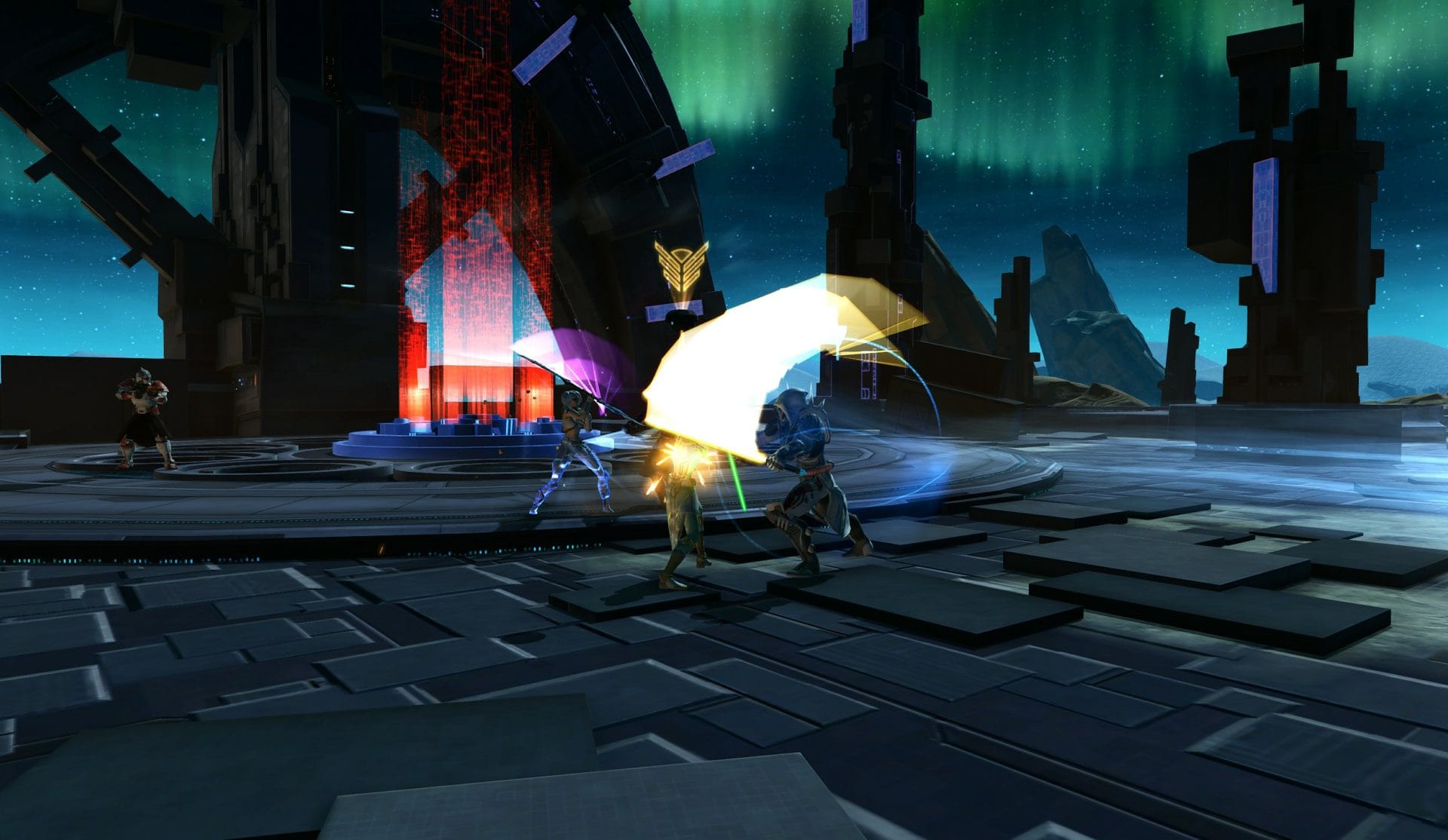
While you wait for reinforcements you must use your DCDs, Warzone Medpacs and Adrenals, and use the terrain to cut off line of sight from your opponents. Cutting off line of sight can prevent targeted abilities from being used on you so they will need to waste time repositioning to use that ability again.
With enough time, you might just live long enough to get help or at the very least, ensure allies can defend the pylon as you respawn.
The Best Pylon Guards
Before we look at the following combat styles, I want to emphasize that any combat style can act as a pylon guard. It’s just that the following tend to excel more than others due to their kits and abilities. If you’re not one of these combat styles as a pylon guard, remember the tips above to maximize your productivity!
Kinetic Combat Shadows and Darkness Assassins
From personal experience, I would argue that the best pylon guards are Kinetic Combat Shadows and Darkness Assassins. They have the durability of a tank and the ability to communicate safely as a stealth unit.
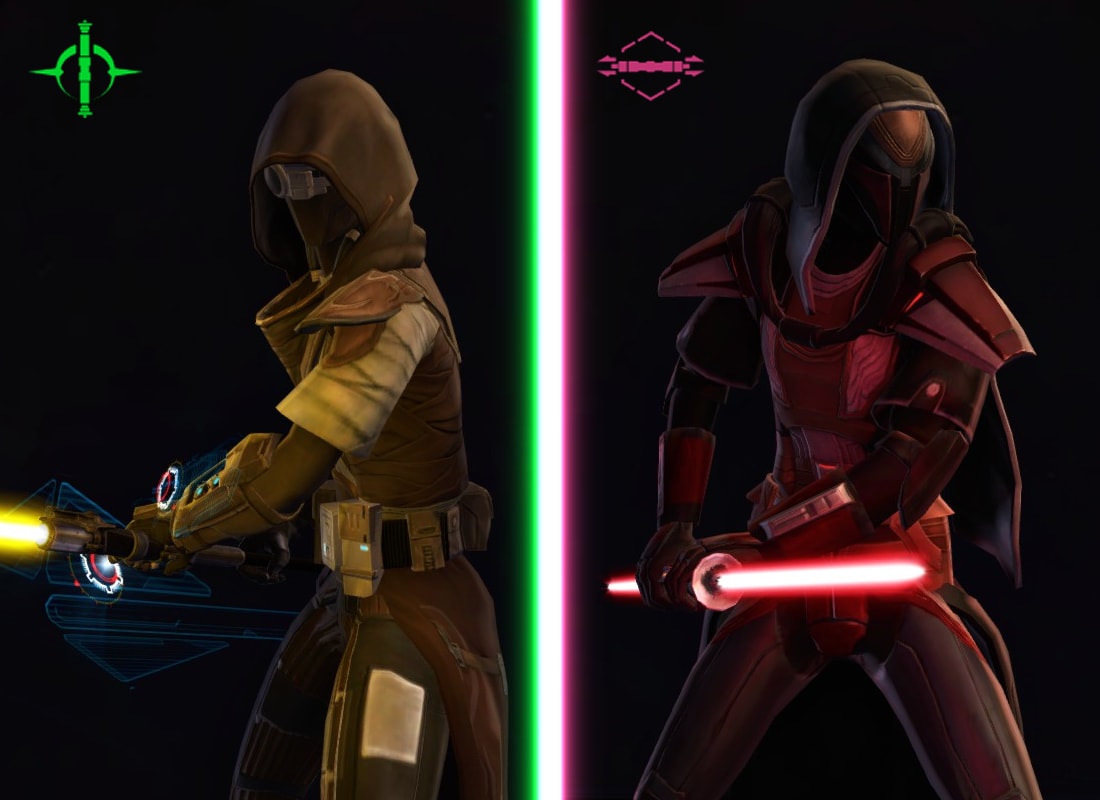
These two aspects fuse very nicely when guarding a pylon as they can move around while stealthed to get different viewing angles without revealing themselves.
They also have a passive stealth detection buff from their combat style which can allow them to see enemy stealth units if they get close enough. Though their strongest feature is the fact that they make excellent duelists and a well practiced Shadow/Assassin can take on just about anyone in the game.
Let’s go over some of their useful abilities as to why they make such great guards.

The ability Deflection grants the Shadow/Assassin +50% Defense Chance for 12 seconds. On top of that, an area around them within an 8 meter radius decreases Force and Tech damage done to anyone caught within. Since Force and Tech damage is very prominent in PvP, this is an excellent ability for reducing damage from numerous caster classes.

The ability Force Wave/Overload is an AoE push that will knock up to 8 enemies back in a 15 meter cone. Targets hit by this ability will be immobilized for 5 seconds though direct damage after the first 2 seconds ends the immobilize effect. With this ability, they can stall an invading team for a good duration of time but even more so with a Rakata Freeze Bomb. The Rakata Freeze Bomb is a consumable grenade that when thrown, deals elemental damage and immobilizes up to 4 targets in the area for 6 seconds. When combined with Force Wave/Overload, the Shadow/Assassin can root 4 people for 11 seconds while barely filling their resolve bars.

If the Shadow/Assassin has the Dusk Ward passive from their ability tree choice, then even attacking them can prove counterproductive. Should all 15 stacks of their Kinetic Ward/Dark Ward break, all nearby enemies will receive a debuff that causes affected targets to lose 20% accuracy for 6 seconds.
DPS Stealth Units
Any stealth unit can serve as a great pylon guard. With their ability to remain invisible, they can safely type incoming while being hidden from enemy eyes. A foolish opponent may think the pylon was left unguarded, dropping their guard.
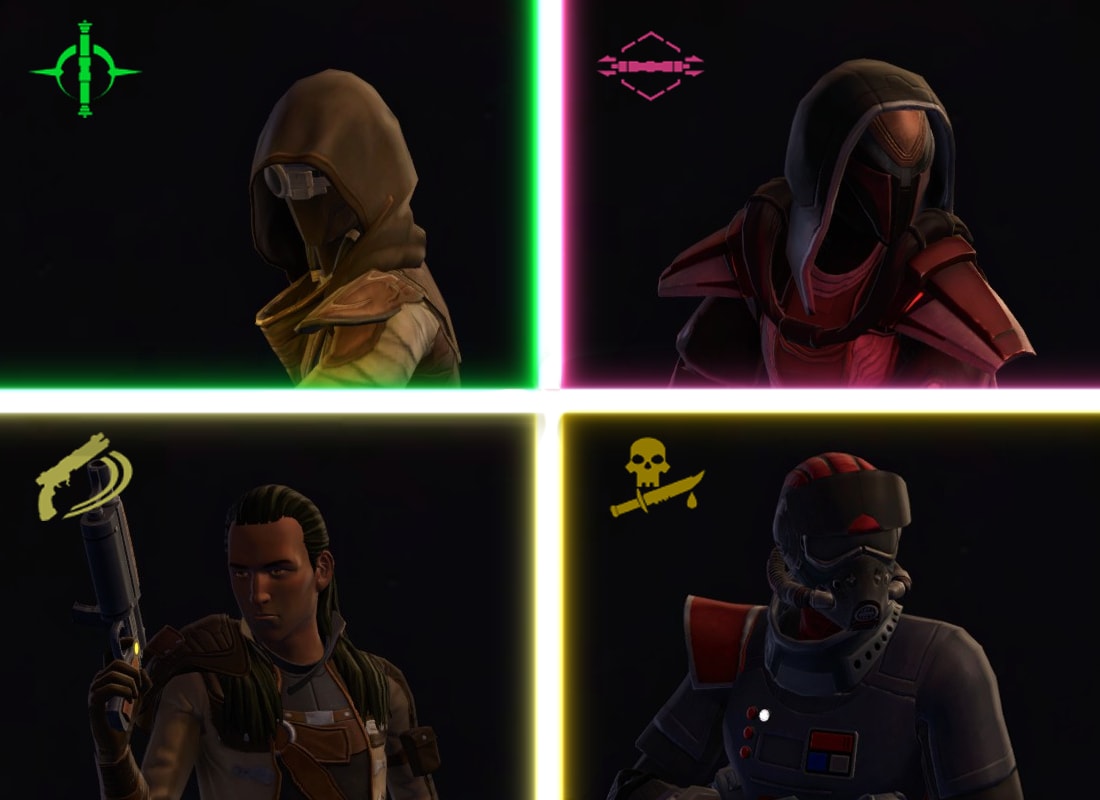
If it’s one thing stealth units love (particularly the DPS variants), it’s getting the drop on an unsuspecting foe. DPS Shadows/Assassins and Scoundrels/Operatives make excellent duelists and should be able to deal with any 1v1 scenario they encounter during guard duty.
Though they will be at a disadvantage if they are outnumbered, they can at least stall by using their mesmerizes from stealth as they wait for reinforcements.
Gunslingers and Snipers
Gunslingers and Snipers can find themselves acting as pylon guards due to their unique passive ability, Ready for Anything/Spotter.
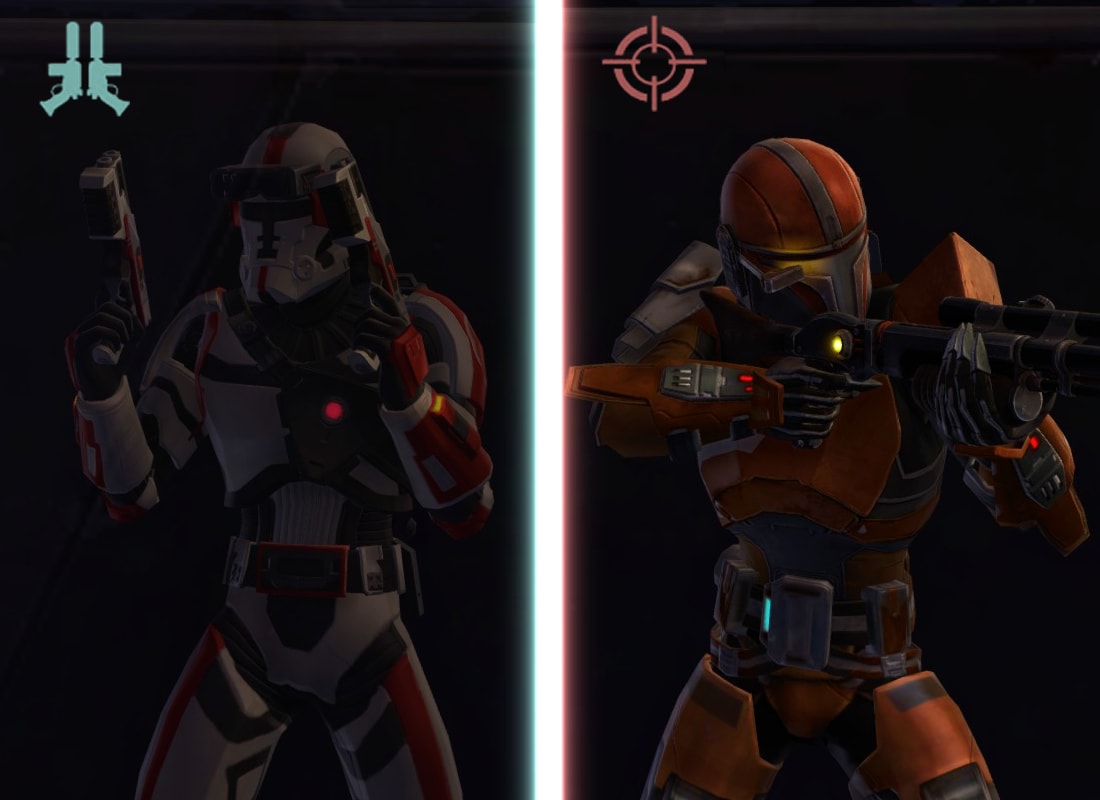
When they enter cover, they build stacks of this ability with each stack granting them one level of stealth detection (up to 30 stacks). This is accumulated once per second over 30 seconds and is lost when they exit cover. The increased stealth detection allows the Gunslinger/Sniper to have better odds of detecting stealth units.
Let’s delve into the wonderful world of how stealth mechanics work in SWTOR for a little bit. Stealth units can enter stealth mode that makes them invisible while increasing their stealth level by 15. This is contested against an enemy’s stealth detection level, in this case 30 for the Gunslinger/Sniper. This means the Gunslinger/Sniper will be capable of detecting a stealth unit within 15 meters, though even then there’s no guarantee.
SWTOR uses a dice rolling system to determine if a stealth unit is seen or not by someone with stealth detection. This is done by rolling the stealth level vs stealth detection once every second. If the Gunslinger/Sniper wins the roll, they can see the stealth unit.
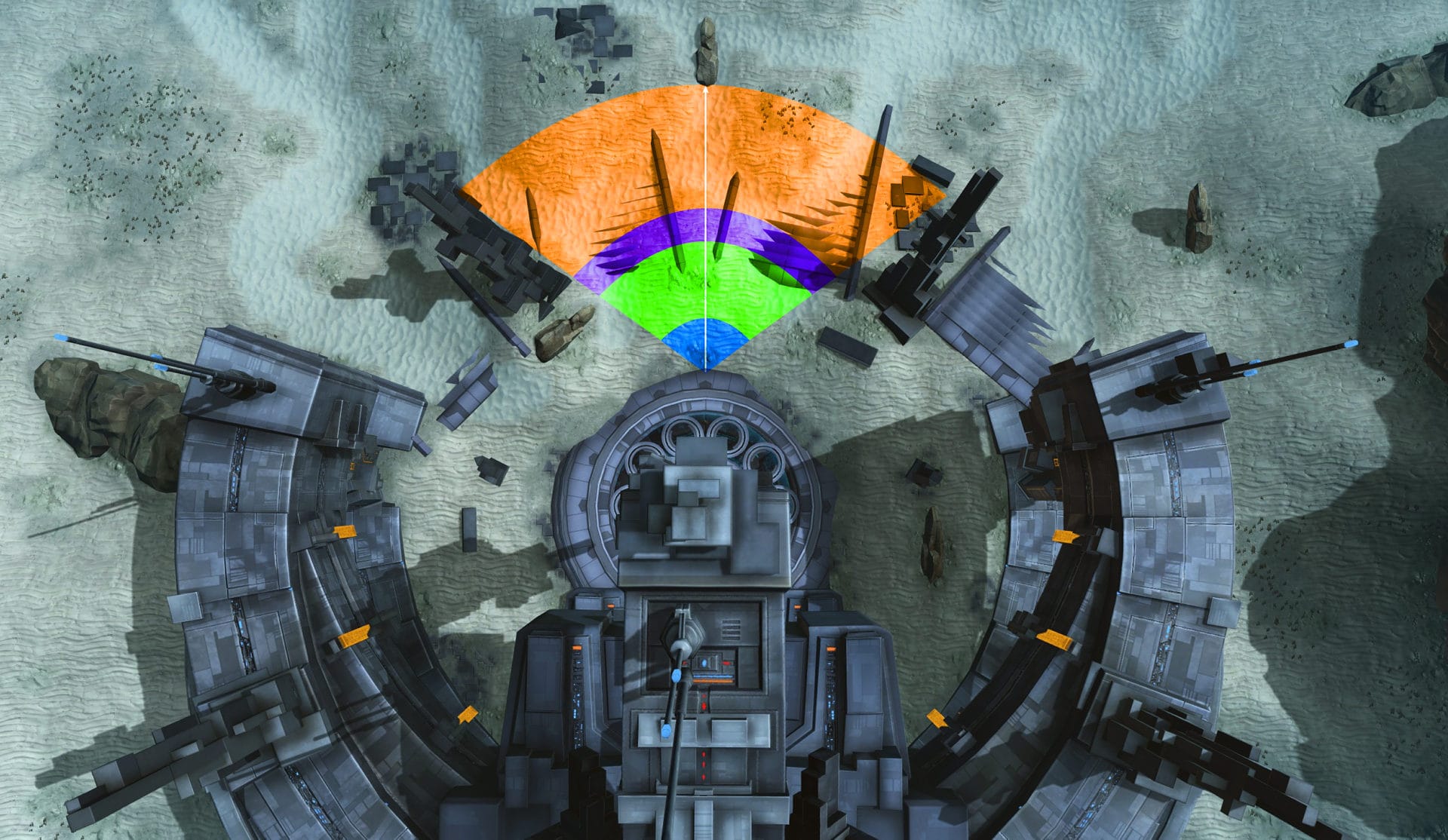
With that in mind, you can see the stealth detection ranges in the images above.
Up to the orange zone is where a Gunslinger/Sniper can detect an untalented invisible unit such as a non-stealther under the effect of the Smuggle/Infiltrate ability.
Up to purple is where a Gunslinger/Sniper can detect an invisible Shadow/Assassin or Scoundrel/Operative who has the basic 15 stealth levels.
The green zone is where a Gunslinger/Sniper can detect a Scoundrel/Operative who has an effective stealth level of 18 with the Sneaky/Infiltrator passive.
Last, the blue zone is where a Gunslinger/Sniper can detect a Shadow/Assassin with an effective stealth level of 25 with the Kinetic Surge/Obfuscating speed passive.
If there were two snipers guarding a pylon, they could overlap their field of view like in the image below.
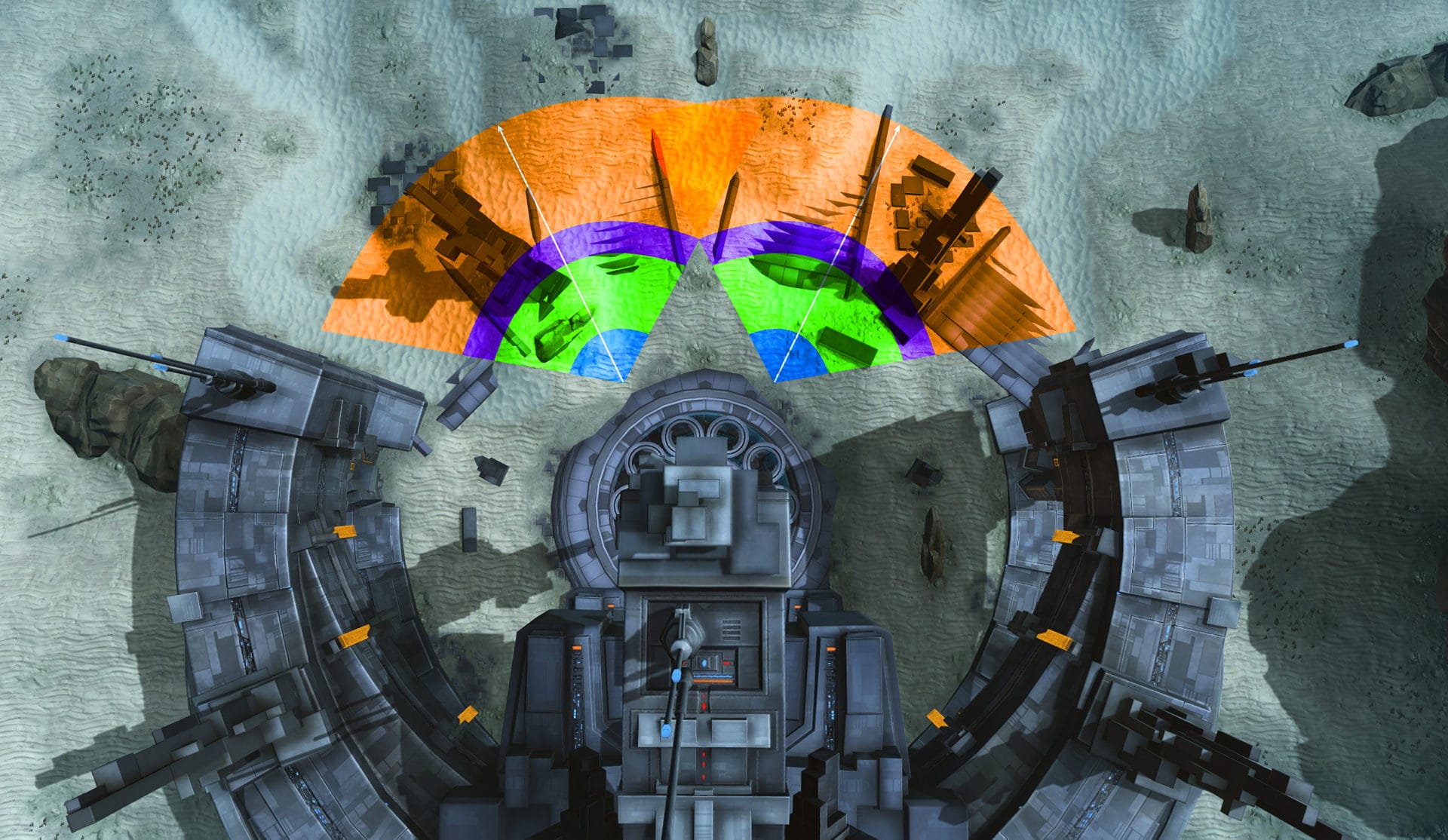
They could get a wide view of the area and detect a large group of untalented invisible units while their stealth detection versus talented stealth units gets smaller.
A flaw with this setup is that a talented stealther could simply walk around and attack the snipers from behind.
This does come at the cost of wasting time to position themselves which may work in the sniper’s favor. Still, gunslingers/snipers should pay just as much attention to their flanks as much as their front.
Stealth mechanics aside, Gunslingers/Snipers cannot be leapt to while under cover so they should be able to deal a large chunk of damage to someone coming their way. Assuming they aren’t already dispatched, it shouldn’t be too hard to finish them off.
The only downside to having a Gunslinger/Sniper is that they work best when remaining stationary which might not always be a great option vs a mobile opponent or if their opponents closed the gap.
How to Capture a Pylon
Capturing a pylon is also known as “capping” a pylon or to “cap”, while capturers can be called “cappers”.
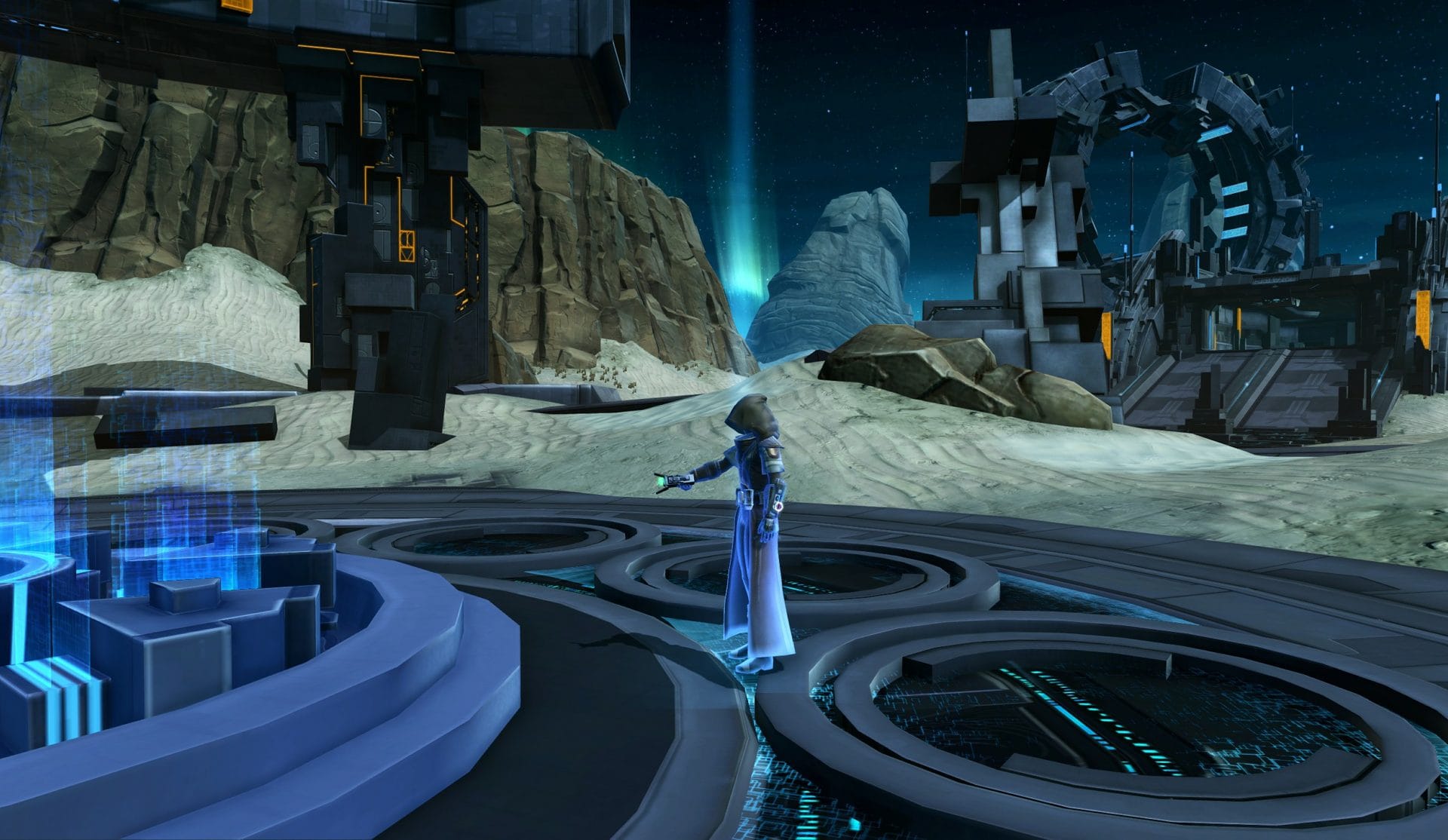
Oftentimes, a pylon controlled by the enemy will have at least one person guarding it. Those who are confident in their dueling capabilities should be attempting to guard or capture a pylon as it becomes a matter of skill when the fight between the guard and capper inevitably starts. Though we’ll be going over some dos and don’ts to improve your ability to take an enemy pylon by force or subterfuge.
The DOs and DONTs when capturing a Pylon
Do:
- Do assess the situation when making your way to a pylon. Look all around your surroundings to see if there are any enemies also making their way there, how many enemies are already there, and what kind of enemy they are.
- Do understand your own limitations. Some combat styles naturally counter others, so knowledge of your combat style and other combat styles can vastly improve your ability to judge whether or not you can secure a pylon.
- Do remember to communicate what you see to your team. If you see one enemy guarding a pylon but 5 enemies are fighting somewhere else, that means there are 2 enemies unaccounted for.
- Do remember that it’s better to leave a pylon guarded by 2 enemies to focus your efforts with the bulk of your team so you can outnumber the remaining enemies.
- Do remember that you need a minimum of 8 seconds to capture a pylon, so a 4 second stun will not give you enough time to capture it.
Don’t:
- Don’t assume that an empty enemy pylon is unguarded. It’s far more likely that it’s being guarded by a stealth unit meaning you should be on your guard. Most stealth units tend to get cocky and use their mesmerize the moment you’re in range. If they do this, take advantage of this if they fill your resolve bar making you immune to CC.
- Don’t needlessly spam click the pylon hoping you can sneak it while under fire. Getting hit by ANY direct damage will stop the channel. If you’re with a group trying to capture a pylon, spam clicking the pylon and failing essentially leaves your team potentially outnumbered as you’re not actively participating in combat.
- Don’t assume your team will capture a pylon scot free. Oftentimes some enemies appear to a pylon just to stall your team from capturing it. If you can, deal with these people by slowing them, incapacitating them, mesmerizing them, whatever it takes to allow your allies to capture the pylon.
- Don’t be selfish and try to be the only one to capture the pylon. If someone else has already started capturing a pylon, act as their bodyguard until the pylon is captured and decide who will be on guard duty.
Best Combat Styles for capturing a Pylon
When it comes to which combat styles make the best cappers, it is no contest, not even by a longshot. The units best suited for the job are stealth units including Shadows, Assassins, Scoundrels, and Operatives.
While the DPS variants can quickly take out a target, healer and tank variants are just as capable of securing a pylon. This is done by using two mesmerizes which can leave an opponent unable to move for up to 16 seconds.
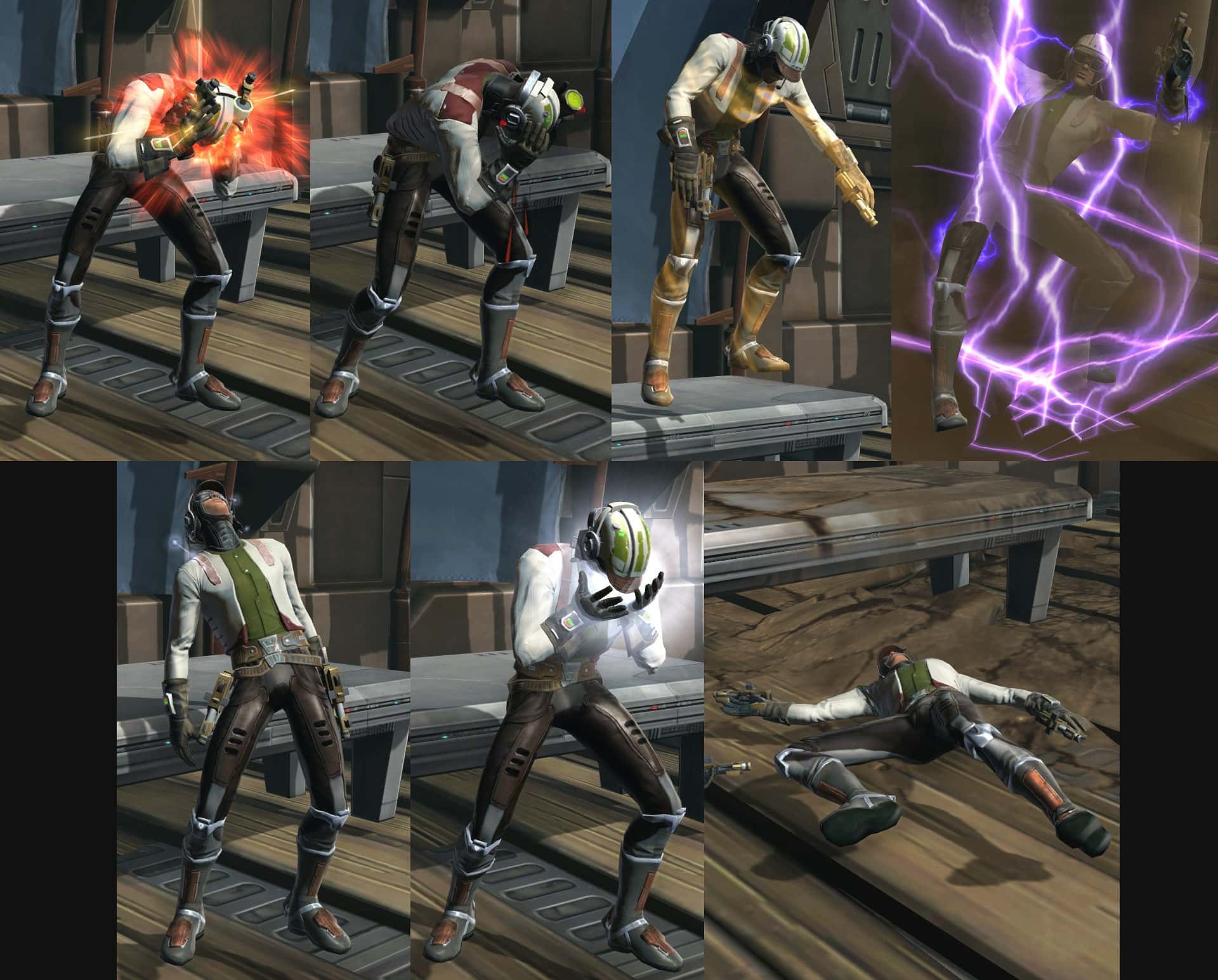
For Shadows/Assassins, they’ll want to use the abilities Mind Maze/Mind Trap and Force Lift/Whirlwind. For Scoundrels/Operatives, they’ll be using Tranquilizer/Sleep Dart and Flash Grenade/Flashbang. Mind Maze, Mind Trap, Tranquilizer, and Sleep Dart can only be used while stealthed, so they’ll be the first incapacitates to be used.
In the event the target uses their CC breaker to stop the capper, the capper can follow up with Force Lift, Whirlwind, Flash Grenade, or Flashbang to leave the target unable to act for another 8 seconds.
As soon as they are incapacitated again, the capper must immediately interact with the pylon to ensure that they capture it by the time the guard breaks free. If you’re a capper who just pulled this off, then congratulations! You are now the pylon until further notice!
This type of combination isn’t limited to stealth units either. Commandos/Mercenaries have access to the Concussive Round/Concussion Missile ability which will incapacitate a target for 8 seconds.
When paired with a V-9 Seismic Grenade, they can also leave a target unable to act for up to 16 seconds. The same effect can be done by a Guardian/Juggernaut using Awe/Intimidating roar with a Seismic Grenade.
If you see an enemy under the effects seen in the image above, please DO NOT attack them. Whoever incapacitated them likely wanted them to remain incapacitated and all of these effects are broken by damage. The incapacitated player WANTS you to attack them so they can break free and defend the pylon.
Ancient Hypergate Strategies
The following strategy scenarios are some that are rather common with their effectiveness depending on the placement of the enemy team. These will assume the enemy team follows the first strategy, the Standard Scenario, and explain how this can provide your team an advantage in the game.
These strategies will be seen from the south spawn’s side but can be mirrored on the north portion of the spawn zones.
Standard Scenario
The most common scenario you’ll see is that 1-2 people go towards the pylon on the left side of the spawn area (left relative to where you spawn facing) while everyone else goes to the middle shelter zone.

Typically the two going to the side will split their duties with the more mobile one going to capture the pylon while the other provides support to keep off any intruders they can see from stopping their ally.
Once captured, one or both may take up guard duty depending on what they are capable of. From there it’s a matter of communicating with their team for incoming players while the majority of the conflict takes place in the middle zone.
Standard Scenario with Stealth
This scenario is essentially the same as the first though this time except one or more stealth units head towards the enemy spawn.
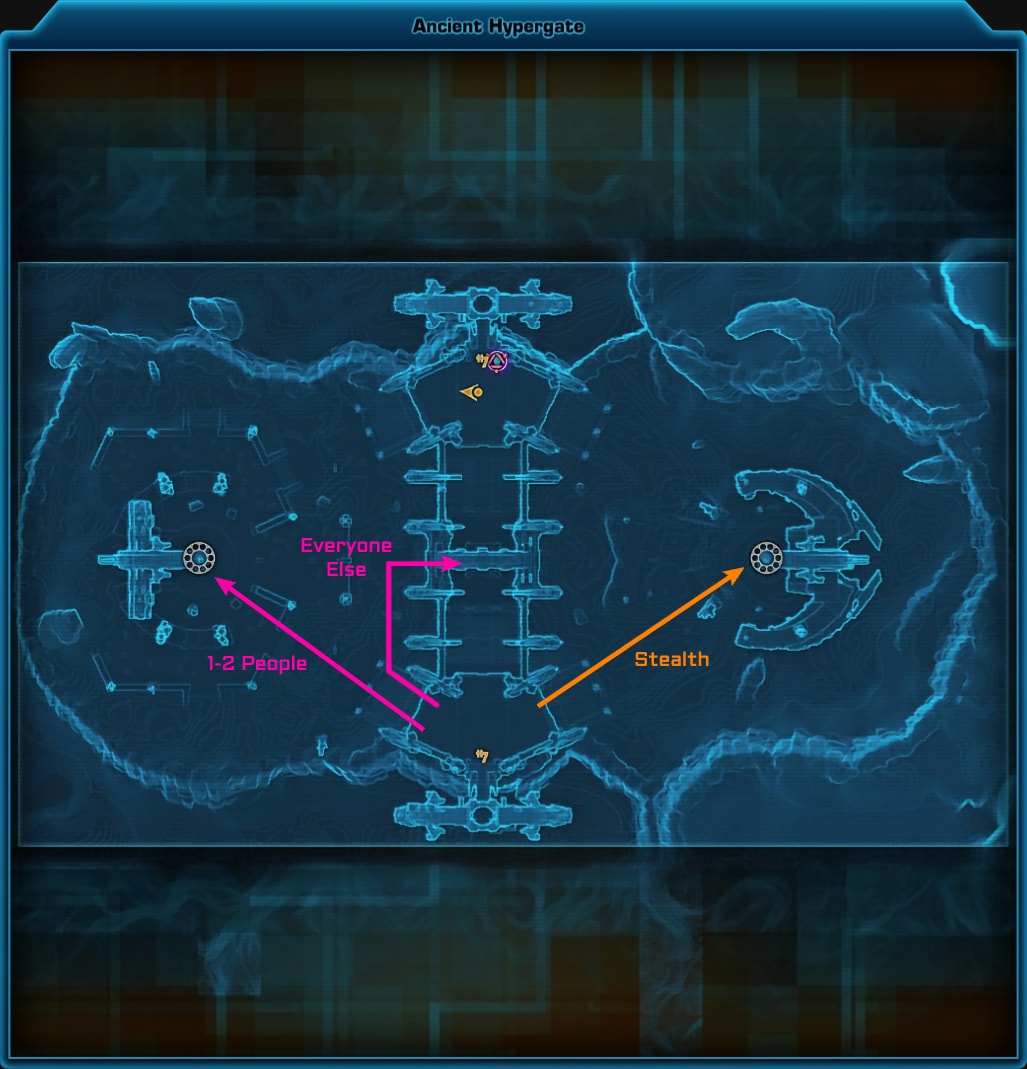
If able, they will dispatch the enemy guard and capture the other pylon to which then the group splits their forces to maintain control of both. Though maintaining a pylon regardless whether it’s east or west this way can be a challenge as both are close to the enemy spawn zones.
Overwhelm the Pylon
In this scenario, you send 1-2 people to the “left” pylon that you have easy access to, 1-2 people to the middle shelter zone, while the rest go to the other pylon.
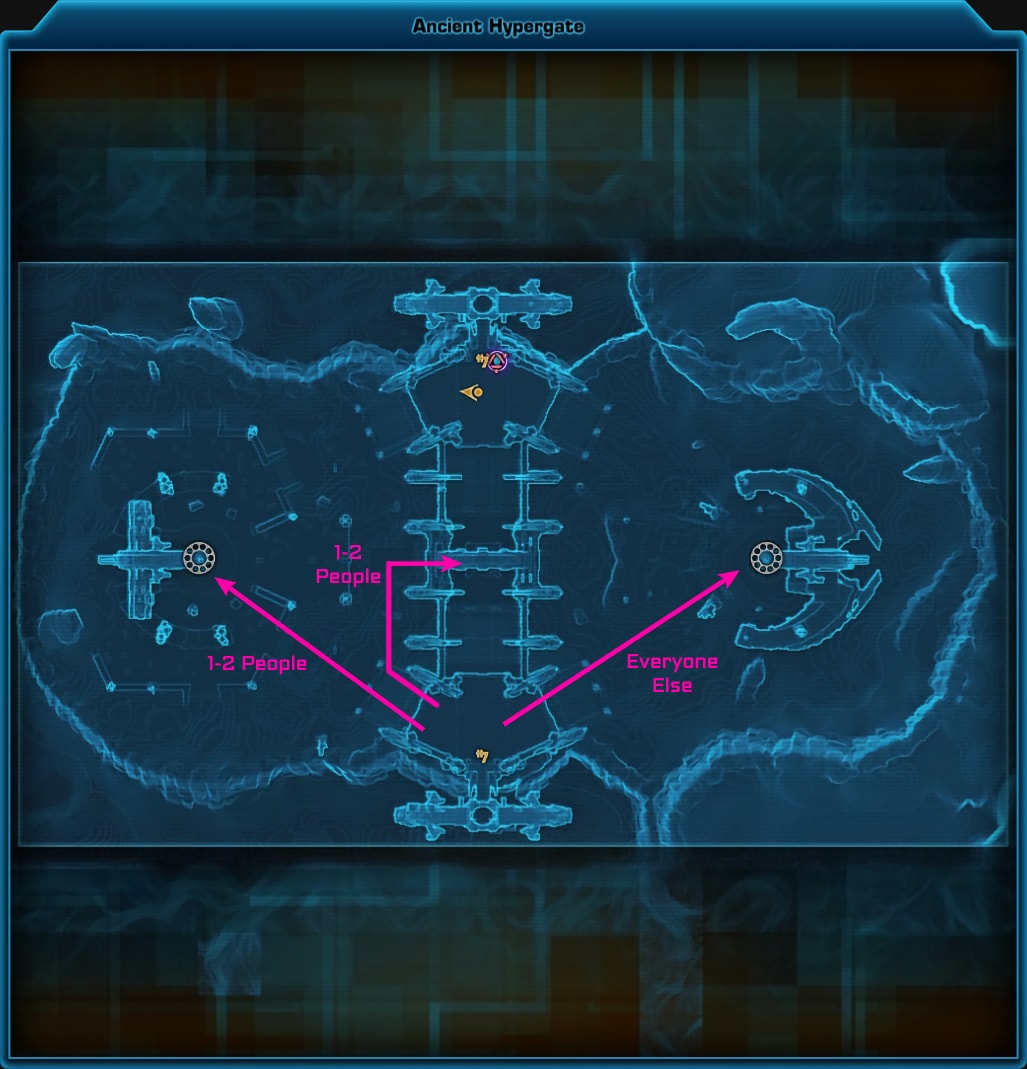
The goal here is to make the enemy panic and allocate all of their team to the typical pylon they capture.
As for the invading team members, their concern is to stall the enemy team for as long as possible to allow their team to capture a pylon and score points with energy orbs.
The longer they can hold out, the sooner they can get their team a lead and get a jumpstart at the start of the warzone.
Recommended Pairings for Invading Forces
Here are some good tank and healer combos for invading forces:
Guardian/Juggernaut Tank + Sage/Sorcerer Healer
Guardian/Juggernaut tanks work really well with Sage/Sorcerer healers since they can actively reduce each other’s incoming damage using the Guardian Leap/Intercede and Static Armor/Barrier. If the healer needs to cast their Force Barrier to protect themselves when under heavy fire, the Guardian/Juggernaut can rely on their Focused/Enraged Defense to heal them for the time being.
Vanguard/Powertech Tank + Scoundrel/Operative Healer
Vanguard/Powertech tanks have the best passive mitigation and work well with Scoundrel/Operative Healers. The healer’s Heal Over Time abilities pair well with the tank’s high passive mitigation while allowing both to remain mobile. This allows both to apply their debuffs and CC in a group while being hard to pin down.
Shadow/Assassin Tank + Commando/Mercenary Healer
Shadow/Assassin Tanks work best with Commando/Mercenary healers because these healers are specialized in dealing large bursts of healing to a single target. Shadow/Assassin Tanks just so happen to be weak to burst damage so having burst healing is great to make up for this weakness. With the Commando’s/Mercenary’s powerful self heals, shields, and other DCDs, they make for low maintenance healers for the Shadow/Assassin tank who can focus their efforts to delay the enemy team.

